Architecture, Sculpture and Painting of the First Goetheanum
GA 288
12 June 19020, Dornach
Translated by Steiner Online Library
V. The Goetheanum in Dornach
A public lecture at the Stuttgart Art Building
When the spiritual science, the aims and nature of which I have been honored to present in lectures in Stuttgart every year for almost two decades, gained greater currency, namely when artistic work was created from this spiritual science, the intention arose to create a central building for this spiritual science that would be particularly appropriate for it, somewhere where it would be fitting. This idea has become a reality in that we performed the Mystery Dramas in an ordinary theater in Munich from 1909 to 1913. These plays were intended to be born out of the spirit of this anthroposophically oriented spiritual science in their entire structure and attitude.
What the supporters of this spiritual science had in mind, on the one hand, as the actual meaning of their world view, and, on the other hand, as the artistic expression of this world view, was initially brought about by the intention, just mentioned, to stage their own play, which was to be the representative, the outward representative of this spiritual science. In Munich, this did not succeed due to the lack of cooperation on the part of the relevant artists. Since I have set myself a different task today, I do not want to talk about everything that led to the construction of this building on a hill in a remote location in northwestern Switzerland, in the canton of Solothurn, where, at the time we began building, there were no restrictive building laws and one could build as one wished. As I said, all this has led to the fact that I do not want to go into it today. But I would like to talk about the sense in which the intention should be understood, especially for the spiritual science meant here.
When one speaks of world views, world view directions or world view currents, then one usually has in mind a sum of ideas that often have a more or less theoretical or popular character, but which mostly exhaust themselves in the fact that they simply want to express themselves through communication, through the mere word, and then at most expect from the world that the word, which is formulated in a certain way programmatically, is actually carried out in reality. From the outset, what is meant here as anthroposophically oriented spiritual science is not predisposed in the same way as other world views. It is, if I may express it this way, imbued from beginning to end with a sense of reality. That is why it had to lead, even in difficult times in this present age, to direct penetration into what the attempt at a social reconstruction of modern civilization is. If a world view that is more in the realm of ideas needs a structure of its own for its cultivation, then, depending on one's means, one usually contacts someone whom one assumes to be professionally capable of constructing a structure from the relevant styles. One contacts such a personality or a series of such personalities in order to then create, as it were, a house, a framework for the cultivation of such a worldview. However, this could not have corresponded to the whole structure of our anthroposophically oriented spiritual science, for the simple reason that this spiritual science is not something that expresses itself only in ideas, but because it wants to express itself in all forms of life.
Now I would like to use a simple comparison to suggest how this anthroposophically oriented spiritual science had to express itself in its own framework, both in terms of trees and in artistic terms. Take any fruit, let us say a nut. Inside the nut is the fruit, and around it is the shell. Let us first look at the hard shell inside the green shell. If you study the whole configuration, the shape of the nut shell, you will say to yourself: it could not be any different than it is, because the nut is as it is. You cannot help but think to yourself: the nut creates its shell, and everything about it that is visible through the shell must be an expression of what the nut itself is. Thus, a frame is quite appropriate in nature, in all creation, for what it frames.
If you do not think abstractly, if you do not think theoretically, if you do not think from a world view that moves only in ideas, but that wants to be in all reality and in all life, then you feel compelled to do everything you do in a certain way, as the creative forces in the universe do. And so, if we had built with some alien architectural style, with something that had grown out of those building methods that are common today, a framework for an anthroposophically oriented worldview and its cultivation, there would have been two things: on the one hand, a building that expresses itself entirely from within, that says something for itself, that stands in its own artistic formal language. And then one would have entered and represented something inside, cultivated something that could only relate to the building in a very superficial way. One would hear words spoken in such a building, one would see plays performed on the stage (since these are intended) and other artistic performances; one would have heard and seen and beheld something that wants to present itself as something new in modern civilization. One would have turned one's eye away from what one might have seen on the stage; one would have turned one's ear away from what one might have heard, and one would have looked at the building forms — these would have become two essentially different things. The spiritual science meant here could not aspire to this. It had to strive in harmony with all world-building. It had to trust itself to express itself in artistic forms as well as in building forms. It had to claim that what forms itself into words, what forms itself into drama or into another form of artistic expression, is also capable of directly shaping itself into all the details of what is now the shell. Just as the nut fruit creates its shell out of its own essence, so too did a spiritual science such as this, whose essence is not understood in the broadest circles today because it breathes precisely this spirit of reality, had to create its own framework. Everything that the eye sees in this framework must be a direct expression of what is present as living life in this world view, as must the formed word.
And there were some pitfalls to avoid. For those who have a certain inclination to make a building appropriate to a worldview are often, let us say, somewhat mystical or otherwise inclined, and they then have the urge to express what is expressed in the worldview in external symbols, in some mystical formations. But this merely leads to such a framing becoming something in the most eminent sense inartistic. And if one had performed a building bearing symbols, one would have wanted to express in allegorical or symbolic form what underlies anthroposophically oriented spiritual science, so nothing would have emerged but something in the most eminent sense inartistic.
Indeed, I must even admit that some people who have come to what is referred to here as anthroposophically oriented spiritual science with their views and currents of life, as contributors or advisors, in the early days of our work in Dornach, were quite inclined to express everything that spiritual science contains in old symbolic or similar forms. I might also mention that those people, who are so numerous, who either out of a certain lack of understanding or out of malicious intent talk about the Dornach building, keep coming to the world with the idea that one can find symbols for this or that, allegorical expressions for this or that.
Now, ladies and gentlemen, it must be admitted that even in what I have to show you this evening, anyone who does not look closely and with a lively sense of perception can find something to use as an expression: There are many allegorical or symbolic elements. In reality, there is not a single symbol or allegory in the Dornach building, but everything that is there is there entirely so that the inner experience of the spirit, which on the one hand is to be grasped in ideas that are expressed in lectures or the like, is experience is to be completely dissolved into artistic forms, that nothing else is asked for in artistic creation in Dornach than: what the line is like, what the form is like, what that is which can be shaped as an artistic form of expression in sculpture, in architecture, in painting, and so on. And many a person who comes to Dornach and asks what this or that means is always given the same answer by me: I ask them to look at the things; basically, they all mean nothing other than what flows into the eye. People often say that this or that means this or that. But then I am obliged to talk to them about the distribution of colors and the like.
I have now tried to show how the building, as a shell, very much in the spirit of nature's own creation, forms the framework for anthroposophically oriented spiritual science. But for that very reason the whole idea of the building had to strive for something new. Now, in all that I am going to say today, I ask you to bear in mind that, of course, much criticism can be made of the Dornach building, that many objections can be raised. And I give you the assurance: the person who perhaps objects most of all is myself. For I am fully aware that the Dornach building is a beginning; that the Dornach building stands as a first attempt to create a certain stylistic form that cannot even be characterized in words today, because its details are not formed from abstract thoughts, but from what is experienced in a living way in that beholding of the spirit that is meant by our spiritual science.
I may mention just one difference at the outset: if we compare the various architectural styles, which, in a certain development of form, still find expression today wherever buildings are constructed, it is apparent everywhere that, basically, the mathematical, the geometrical, the symmetrical, that which perhaps follows in the rhythm of the line, the mechanical, the dynamic, etc., all flow into architecture. From the basic feeling – I am not saying from the basic idea, I am saying from the basic feeling – of our spiritual science, the daring attempt was once made, I know it, to create an organic building idea, not a mechanical-dynamic, but to create an organic building idea, and this under the influence of that which Goethe incorporated into his great, powerful view of nature under the influence of the idea of metamorphosis. The Dornach building, as far as this can be realized in architecture, should not merely represent the symmetrical, the dynamic, the mechanical, the geometrical; it should represent something that can be looked at, I do not say grasped, but looked at as a building organism, as the form for something living.
In this case, however, it is a matter of every detail in an organism being exactly as it should be in its place. You cannot imagine the ear lobe in a human organism being formed any differently than it is. So we tried to make our building in Dornach a completely organic, internally organic unit by placing each individual part in the whole in such a way that it appears as a necessary structure in its place; that every detail is an expression of the whole, just as a fingertip or an earlobe is an expression of the whole human organism.
That is one thing that has been attempted. As I said, it is a beginning, an attempt, and I know how many imperfections it has and how much can be objected to from the point of view of architecture and sculpture and so on. The other thing is what I would like to say in advance, namely that our world view itself demands that the whole idea of building be formulated differently from the way in which the idea of building is usually formulated. If we consider ordinary buildings – I will mention just one – we find that they are closed off from the outside by walls to a certain degree. Even the Greek buildings were closed off to a certain degree. What is required by the Dornach building is that the wall itself be treated in a completely different way than it is usually treated. The person who enters the Dornach building should not have the feeling that, having a wall around him, he is closed off in an inner space. Rather, everything should be artistically designed so that, to a certain extent, the wall itself is suspended; that the wall itself - please do not misunderstand me - the wall itself becomes artistically transparent, so that one gets the feeling - transparent is of course only spoken in comparison - you are not closed off, but everything that is wall, everything that is dome, opens up a feeling that it is broken through, that it cancels itself out, that you are in a feeling connection with the whole great universe. Far out into infinity, the soul is meant to feel connected to this through what the forms evoke; the forms of the columns, the walls, the forms of the dome paintings, etc.
The building in Dornach is a double-domed structure, consisting of a small and a large domed space that do not stand side by side but interlock. The small domed room, that is, the circular room covered by a smaller dome, will be used for presenting mystery dramas, for dramatic performances in general, for other artistic performances, such as eurythmy. But there are also other things planned. Then there is the large domed room, which is connected to the smaller one in the segment of the dome. It is intended as an auditorium; so that those who approach this building must immediately be imbued with a certain feeling by this outer form.
We will begin by looking at our building as it presents itself to someone approaching it from the northeast.
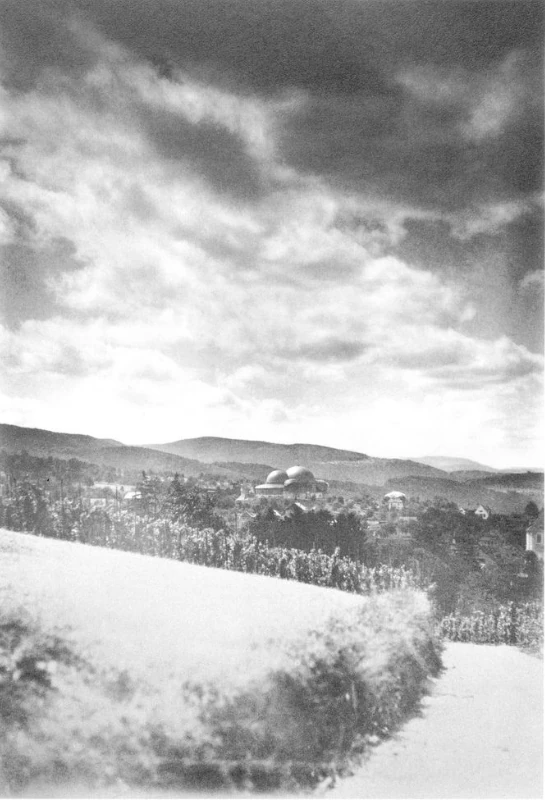
So, as you can see, we have a double-domed structure. This is the auditorium, and here is the stage. The two domes are inserted into each other by, if I may say so, a special technical feat, because this insertion was difficult. The person who approaches this building – which, I believe, is particularly appropriate in its artistic expression of the special mountain formation of the Jura region in which it is built – should have the feeling that something is present that reveals itself in a duality. The person who enters the building finds themselves in the large domed room. Inside, he may have the feeling: here something is seen, something heard. And this something, which is experienced in a sense in the heights of spiritual life, which is to reveal itself to an inclined audience, should already express itself as a feeling to those who approach the building.
But initially, every single detail of the outer forms is attuned in such a way that one has an impression from the outside, so to speak – I could not express it in terms of ideas or thoughts – but through the forms, through the artistic language forms, one has an impression from the outside of what is actually being proclaimed inside as spiritual science. I would now like to show you another approach to the building, which presents itself when approaching it from the north:
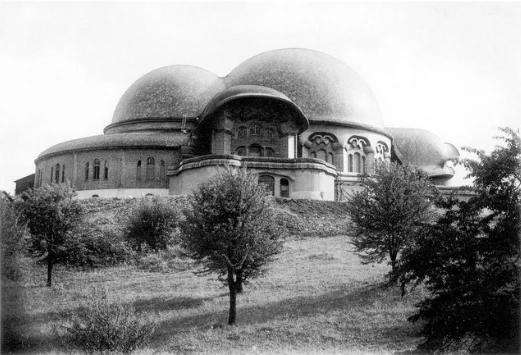
Here is the building, here the main entrance, here a nearby building that has experienced very special challenges. I would just like to mention in this picture: the lower part of the building is a concrete structure. It has a walkway here. The entire building stands on the concrete rotunda. The entire double-domed structure is a wooden construction.
I note that the task was not only to create a shell for spiritual science in this building, but also to find a style for this very special institution that could be derived from concrete. That, ladies and gentlemen, is what is not really understood today, that we have to create out of the material everywhere. Today we see how sculptors create things that they shape, I would say, by having some kind of novelistic idea or a novelistic harmony of ideas, which are then shaped in any material, in bronze or the like. But we have to come back to having such an intense feeling for the material that we ourselves, even with this brittle, I mean artistically brittle, this abstract concrete material, gain the ability to create forms of design out of the material.
It is certainly the case that today people will not understand you if you say to them: I am going to paint a picture; in the middle I have this or that figure, on the sides this or that figure, I now want to do that, can you do something like that? And one answers: Yes, you can do anything, but it is a matter of what becomes of the colors. You cannot talk about a picture differently than from within the colors. Even in many artistic circles today, there is little understanding when one tries to think that which lives artistically as something quite separate from everything that is not direct contemplation, direct experience of feeling.
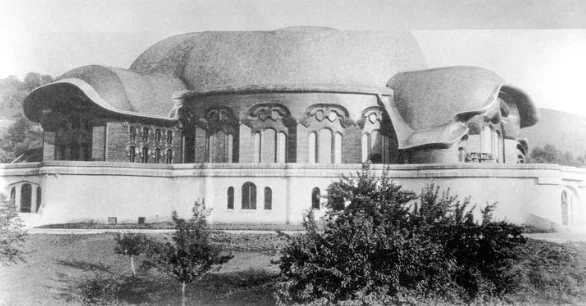
As the third picture, I would like to show you another aspect of the building. You can see the small dome, the large dome. Here, seen from the outside, the auditorium. The whole thing sits on the concrete substructure here. Here are the side wings, which fit into the building at the point where the two domes merge.
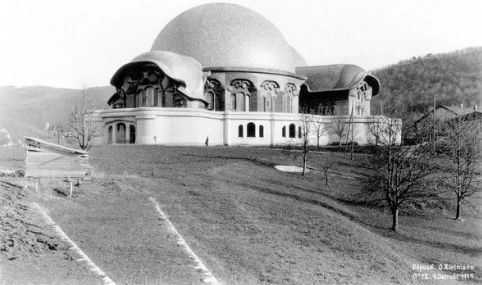
This is a slightly closer view of the structure. You will be entering from down here. The cloakrooms are located in the concrete substructure. There is a stairwell at the front of the interior. You can come up to this level through the wooden structure, but you can also come up here, where there is a walkway. You can walk around a large part of the structure here during the intervals between performances.
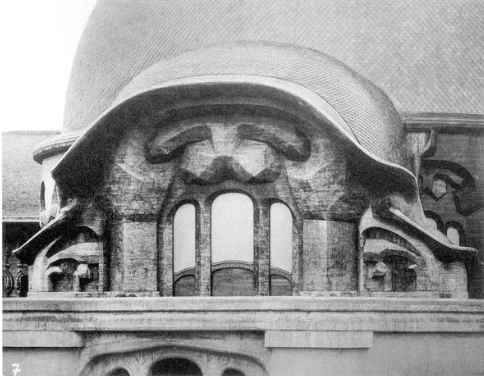
This is the main entrance from the terrace. You can already see that all the forms from the dynamic geometry have been transposed into the organic, into the living. There is nothing in this building that has not been created in the spirit in which I meant the design of the earlobe on the human body earlier. So everything, every detail and the whole, is designed in such a way that not geometric forms, but organic forms are present; but not, I would like to point out, organic forms that are modeled on this or that organic limb. That was not the intention at all. When I had first designed this structure in the wax model, from which the building then emerged, it was not a matter of reproducing anything naturalistically in organic forms, but rather of immersing myself in the creative essence of nature itself, of making what Goethe calls the truth, so to speak, of how nature lives in its creation.
Now, of course, nature does not create such structures. Therefore, one does not find those organic forms in nature that can occur in such a structure, but by having the whole structure like an organic being in its intuition, in its imagination, the inner creation is formed in such detail that detail that, without imitating anything in nature, one is compelled to shape a structure like the one above the main entrance in the same way that a plant leaf is shaped out of the essence of the plant organism. So without imitating anything naturalistically, natural creation should reveal itself everywhere without symbolism and allegory, purely by proceeding in the design of the building forms as one can imagine that nature itself lives in its creation.
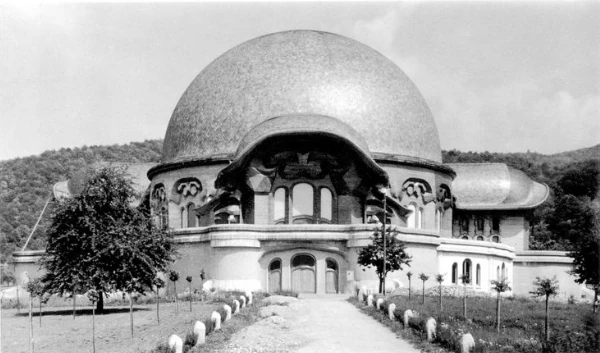
Once again, closer to the building. We are in front of the main entrance. This is where people will enter first. These are the cloakrooms. Then you come up through the stairwell and enter a vestibule, which I will also show later. This is the north side. Behind here are the storage rooms, the rooms for the equipment and the cloakrooms for the stage plays.
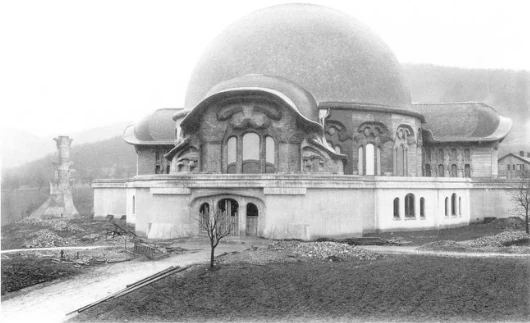
Another view of the main entrance. Here, the smaller dome is completely covered by the large dome. The two side wings were intended as dressing rooms for the performers.
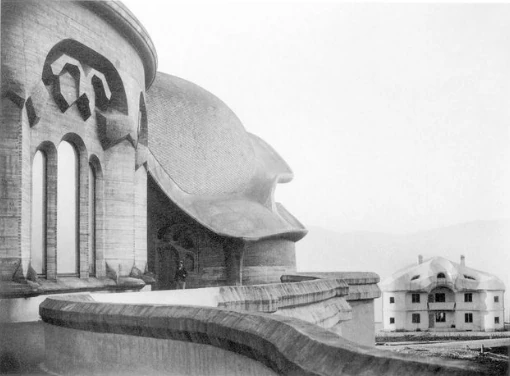
This is a piece of the side wall. Next to it is the house that the man who was able to give us the land for this building had built. This house was built for him in a style that is certainly, since it is all a beginning, completely thought out in all its individual forms using the concrete material. That is what I would like to say about this house.
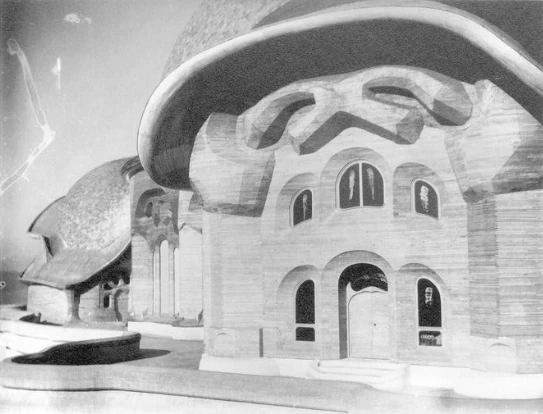
Here you can see one of the side wings, which, as I said, are intended to provide dressing rooms for those performing in the stage festival. If you walk around here, you will come to the main entrance. Here is a piece of the facade of such a side wing. It has been attempted to follow Goethe's idea of metamorphosis – not in a pedantic way, but in the spirit of transforming the ever-identical, of transforming the ever-uniform, to form everything as an organic unity, so that the motif above the main entrance is repeated here, but in a different form. As you will see in Dornach in general, what Goethe calls changeability in organic structures has been tried to be expressed in the building idea everywhere.
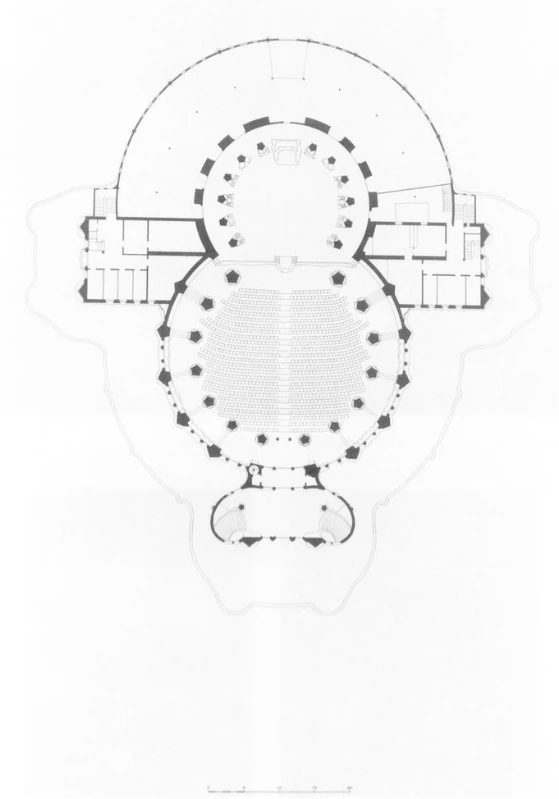
Here is the floor plan, here is the entrance, and there is the auditorium, which will hold about nine hundred to a thousand people. When you come out of the main entrance here, you walk through the space that is vaulted by the organ room above. You then come in here. The line that goes in this direction is the only symmetrical one in this building. Nothing else is oriented in a symmetrical way except for what lies to the left and right of this axis of symmetry. Therefore, as you enter the room, you see a row of columns. These columns are formed in such a way that only the symmetrical pairs always have the same pedestals, the same capitals and the same decoration in general. The formation of the capital progresses as one moves from the entrance towards the stage, so that each successive capital is formed in such a way from the previous one that the space of the architrave above a column is formed from the spatial design of the architrave above the previous column, so that the metamorphosis view is expressed in the right sense.
It is, I dare say, a great thing to attempt such a thing: here you have a first capital with very definite forms that arise inwardly for you as you shape them. And as you say to yourself, now it is so that it must remain in the place where it is, then the feeling comes: That is also to be transformed, just as in a plant growing out of the ground, a subsequent leaf is something metamorphosed in relation to the preceding leaf. There you shape the next form out of the previous one. There the next form presents itself as something absolutely necessary. People often come to Dornach and ask: What does this or that chapter mean? My task is simply to say: look! It is not a matter of someone finding an abstract, complicated meaning, but of sensing how the following chapter always grows out of the previous one in organic necessity.
The smaller dome, framed by twelve columns, and the fourteen columns here, will provide space for the presentation of stage plays. Often, people also count when they come: one, two, three, four, five, six, seven. Seven columns! Then they say: They are mystics, they bring in the superstitious number seven. I can only say: Then nature is also superstitious. The rainbow has seven color shades, we have seven tones in music, the octave is the repetition of the prime. What is so self-evidently expressed in nature is repeated in the direct experience of creating something metamorphic. And I may well say: it was far from my mind to pursue some mystical number seven, but it was obvious to me to think of one capital out of the other. And then a wonderful thing happened – if I may call it a miracle – that just as there are seven colors in the rainbow, without any mysticism, simply by shaping the form, when you are finished with the seventh form, you can't think of anything more. That's how you get the seven forms. With the seventh, you can't think of a single small artistic idea, so you just know you've finished.
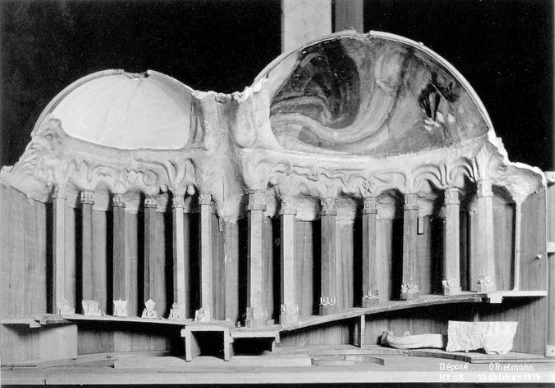
This is a section through the original model. It is cut through the axis of symmetry, so that you can see the formation of the columns in progress, the architraves on top, the bases. So this is the model on which the construction was based.
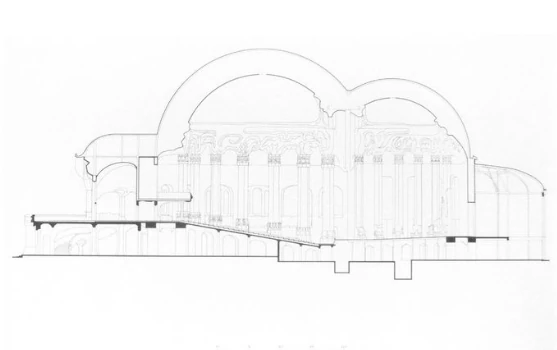
Another section, a kind of drawing section through the building. Here is the concrete substructure. Here we have to show how the two domes are joined together. But here too, two domes are joined together, leaving the space between them free.
I originally had a specific idea in mind when arranging the double dome. When building such a thing, the most important thing is the acoustics, and I had the idea that if you connect two such domes with a connection that is as light as possible, a kind of soundboard must be created.
Furthermore, not for mystical reasons but for very real ones, I had the seven columns made out of different types of wood. All of this, of course, yields a great deal when one tries to think and feel it all together. But many people know how difficult it is to get the acoustics right in a hall. Basically, everything was thought out, down to the choice of materials – as I said, the columns are made of different types of wood – and into this soundboard, so that both the sound that develops in the musical sense and the sound of the spoken word are accentuated in a beautiful acoustic way throughout the entire room.
Just as the whole thing is an experiment, and one could not think that the most perfect thing could be created in the very first attempt, so I could not indulge in the illusion that the perfect acoustics had been created. But we were able to experience how the intuitions revealed something in the very last few days. The organ was installed as the first musical instrument. It was completed, and it became apparent to us that the entire structure, in terms of music, reveals itself acoustically in a very unique way. And I dare to hope – things are not yet ready, that can prove this – but when everything is there, including the curtain, that then the acoustics, including those for the spoken word, will also reveal themselves. But in any case, the one rehearsal for the intuitive design of a space with regard to the acoustics, the one rehearsal in terms of the music, seems to me – and as it seems to everyone who has heard the organ there in the last few days – to have actually been successful.
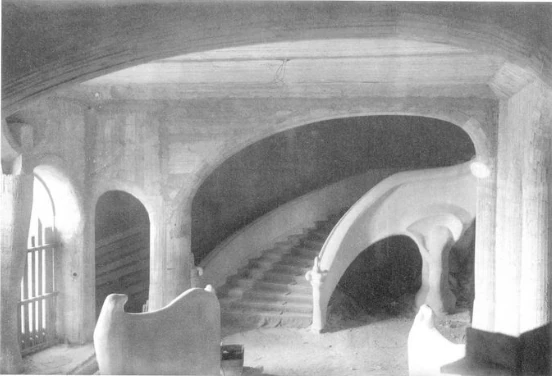
A little way into that staircase, which you enter when you come through the main entrance into the interior. You see here a capital above a column. You see this capital formed in a very special way. Every single form, every single surface, every single curve is conceived with the space in which it is located in mind. The line and surface run this way because this is where you come out, because there is little to bear. Here the column braces itself against the building. Here the individual forms must be shaped differently. Just as nature creates differently when it creates a muscle, depending on what it has to bear, so we must experience how the forms must be when each individual link in its place is to be thought of as it can only be in this place through the nature and essence of the whole.
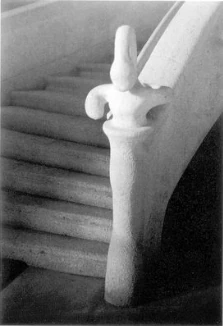
This is the staircase itself. The staircase goes up here. What I showed before is the vestibule above the concrete room. This is where I am standing, and this is where you would stand when you enter the building. Here is the banister for the staircase that leads up from the lower concrete substructure to the building, which is then made of wood, to the actual auditorium. I have tried here to transform a support from the merely geometrically mechanical to the organic.
Let me reiterate: I am, of course, aware of all the objections from the point of view of conventional architecture, but it has at least been attempted, and I have the feeling, however imperfect everything is, however many objections there may be, that a start has been made that paves the way for a new architectural style that will be further developed. Perhaps it will lead to something quite different from what has been built in Dornach, but if you don't even start with something, nothing new will come of it. Therefore, even if it goes completely wrong, something new should be attempted here: the development of the mechanical-dynamic form into organic forms. The concrete is worked in such a way that the beam expresses in its own form what it bears; on the other hand, it is shown here how it only forms outwards, bearing nothing.

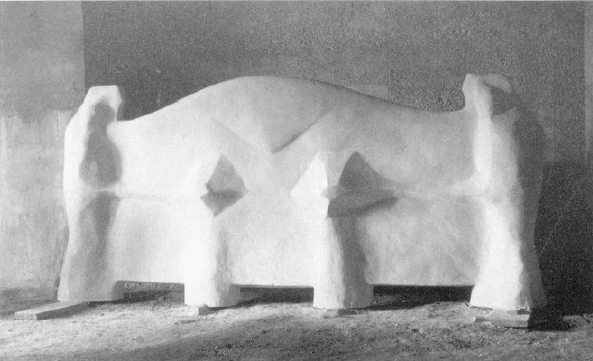
Here you can see a radiator screen. The individual radiators are covered at the bottom with concrete screens and at the top with wooden screens. These screens are designed in such a way that their plastic forms reflect something that, in its formation, is, so to speak, in between animal and plant forms. It comes from the earth, as if organically grown, but not symbolically, but artistically designed. In creating this, one has the feeling of something coming into being if the earth itself allowed something like this to grow out of its principle of growth. If you take this staircase, you will come to the room that was shown before, and through that you then enter the actual auditorium.
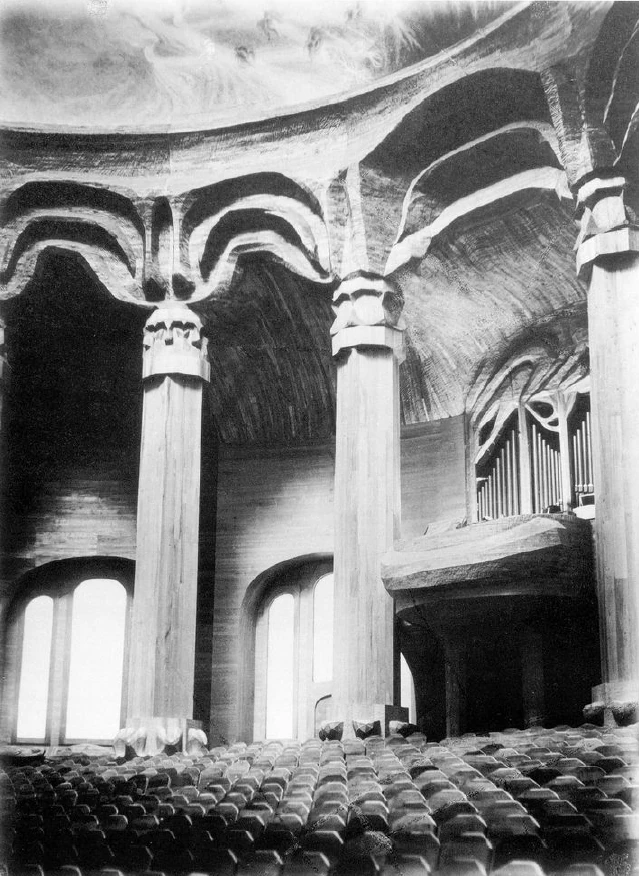
So this is where you come in, enter the auditorium. Here on the left and right are the first two columns. You can see how the simplest capital structure, the simplest architrave structure, is used here. And now you will see how each subsequent capital structure attempts to create something that necessarily grows out of what has gone before, just as a subsequent plant leaf, which is more complicated and more dissipated in form, always grows out of the one that went before.
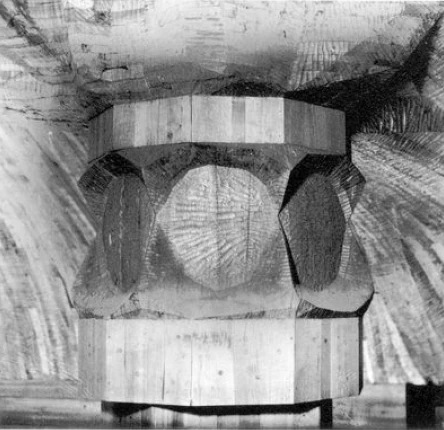
Here is the first column individually. It is always important to me that one sees that the essential is not: what does the individual column mean? Some people have done a terrible disservice by always talking about the meanings of the Dornach columns; it is important to me that the artistic form must be questioned. Therefore, I will always show the one column and the next one, so that it becomes clear how simply, artistically, the next form was attempted to be derived from the preceding one.
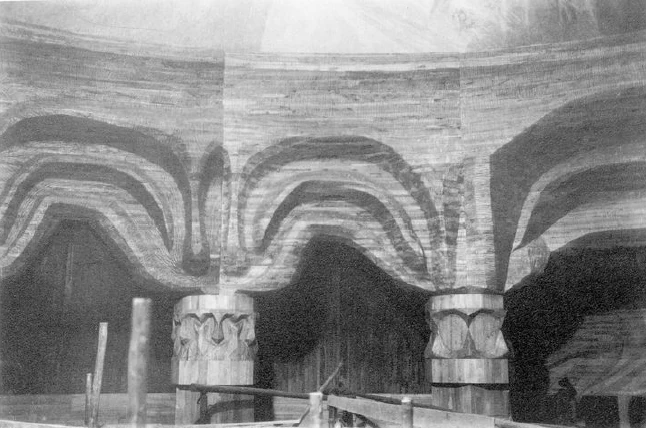
So here, continuing from the simple column – that is the left aspect – we have the second column. It is designed in such a way that what goes down here goes up there. Just as a plant leaf develops from another, this capital form is derived from the preceding one through artistic experience, and this architrave form from the preceding one.
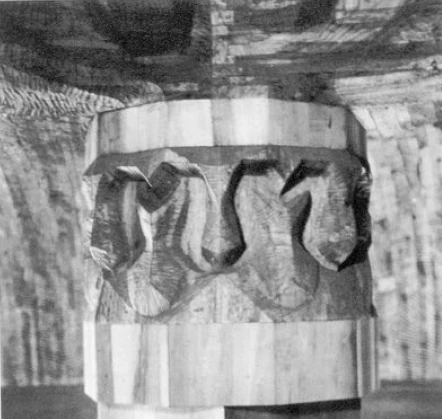
The second column by itself. Now the following two columns, always to illustrate how the next column is to be artistically designed from the previous one. There now follow several column pictures, initially single ones, then in twos.
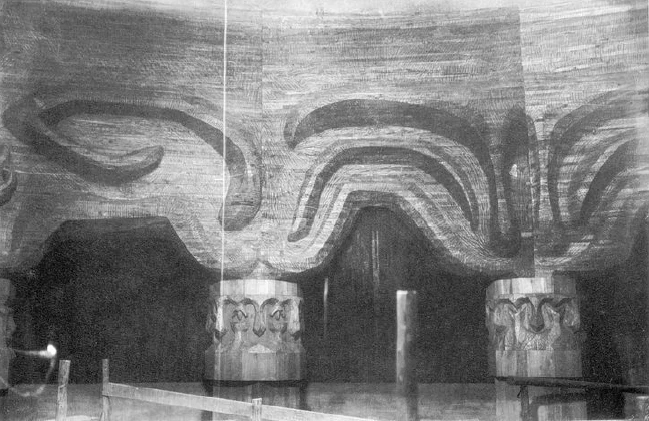
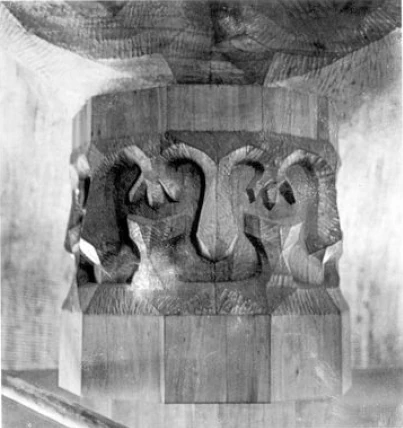
Everything that one experiences artistically is actually formed in one's imagination as a matter of course. One cannot help it, it just happens. One can hardly say anything else about it either. But the strange thing is: when one simply transfers one's own experience into the forms, then one gradually feels how one creates in harmony with nature's own creative process. One feels the life that lies in the shaping of one metamorphosis out of another, in intimate harmony with natural creation. And so I believe that those who experience – not intellectually, but with lively feeling – what develops there as one capital out of the other actually get a more vivid sense of development than can be given by anything in modern science. For when we speak of development, we usually mean that each successive structure is more complicated than the one that precedes it. This is not true. When one inwardly experiences a development such as this evolution of columns and architraves, then at first the simple develops into the complicated. But then one reaches a height, and then the structures become simpler again. You are amazed when you see the results of artistic necessity, how you create in harmony with nature. Because that is how it is in nature too. An example: the most perfect eye is the human eye, but it is not the most complicated eye. The animal eye is much more complicated than the human eye; in certain animals there are fans and xiphoid processes; in humans this has been absorbed again. The shape is simplified. You don't follow that when you create something like this from abstract ideas, but it presents itself to you as something self-evident in the form.
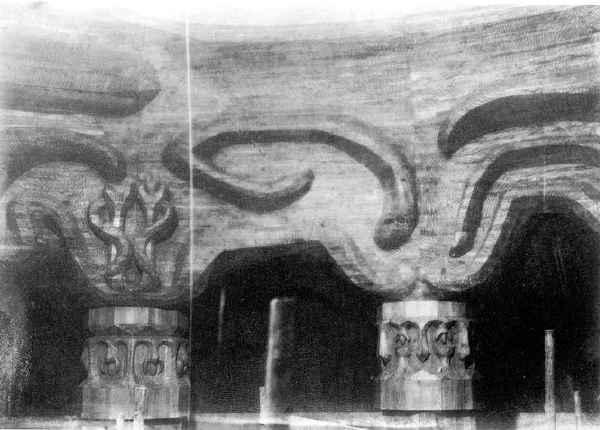
The next two columns. Here we come to something that the abstract mystic or mystical abstractor might say: “He formed the caduceus here.” I did not form the caduceus, I let the preceding forms grow. It formed by itself. It emerges organically, by itself, from the preceding form. I had to say to myself: “If the preceding column grows just like that, it will come out like that, one from the other.”
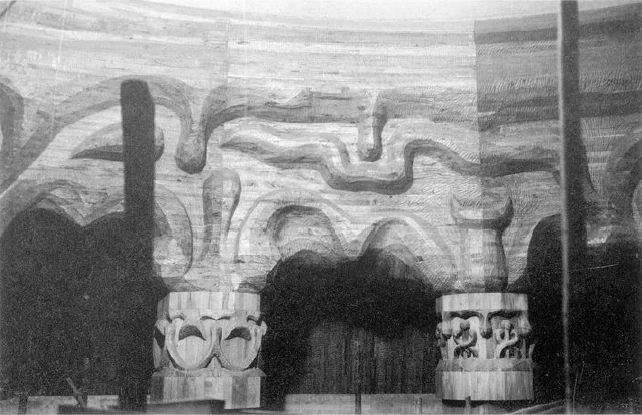
Two consecutive columns showing how the forms become simpler as development progresses.
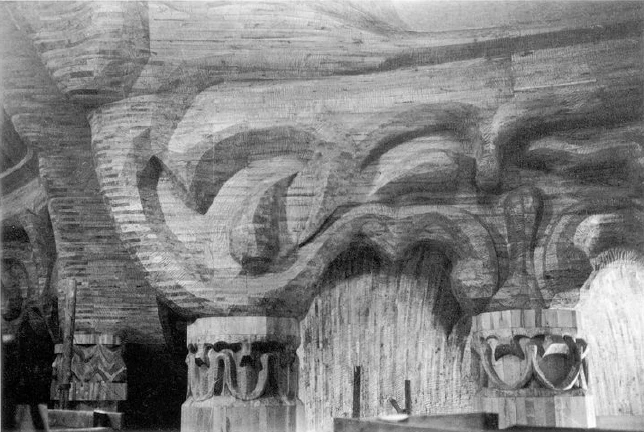
Here we are already approaching the gap where the auditorium borders on the stage.
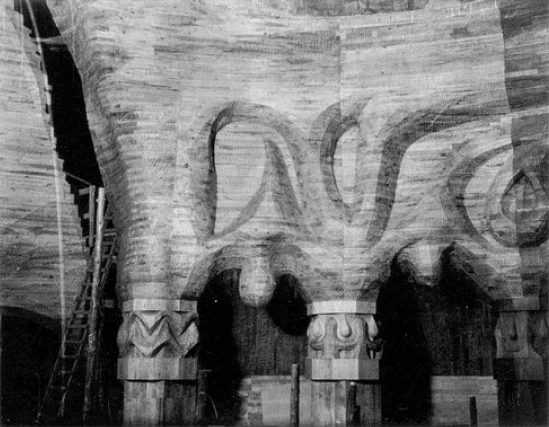
Here the first column of the stage area; here the last of the auditorium, here the gap for the curtain.
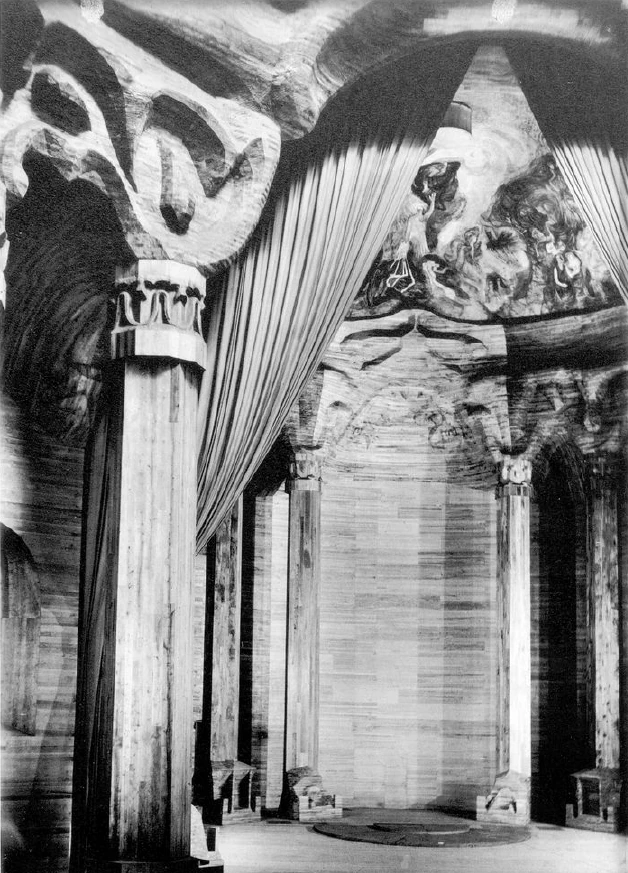
Here you can see into the small domed room. If you stand in the auditorium and look that way, you get a view similar to this. The top of the dome, initially carved and then painted. We won't look at the painting here, we'll come to that later.
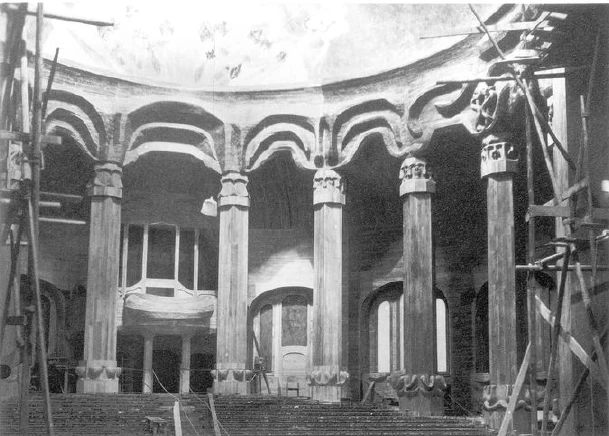
Here I would like to show the order of the individual columns, so that one can get an overview of how the matter progresses from the simplest. All the individual columns are formed individually for each column, and symmetry is only found in relation to the main axis of symmetry of the building.
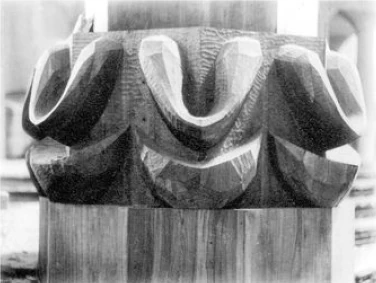
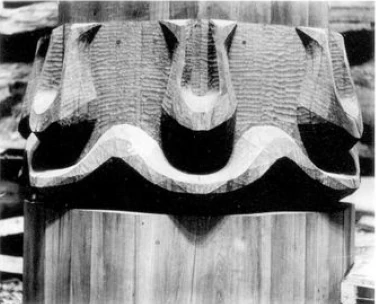
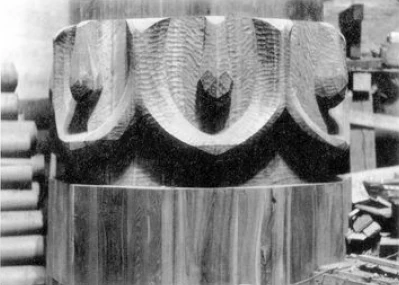
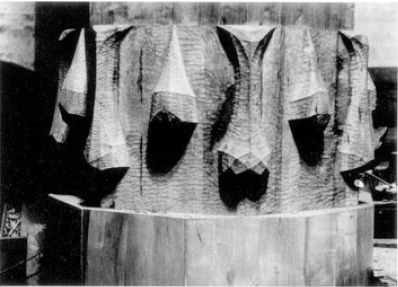
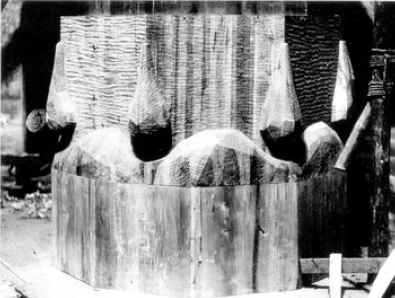
Here are the figures on the pedestals. I also tried to give the pedestals a metamorphic appearance.

I would like to ask you to take a look at something that is not quite finished yet: the room in which the organ is built. The idea was to avoid making the organ look as if it had simply been placed in the room, and instead to make the whole structure appear to grow out of the room. That is why the architecture around the organ is designed to match the way the organ pipes have to be constructed. It is not finished, as I said. There are still things to be added here.
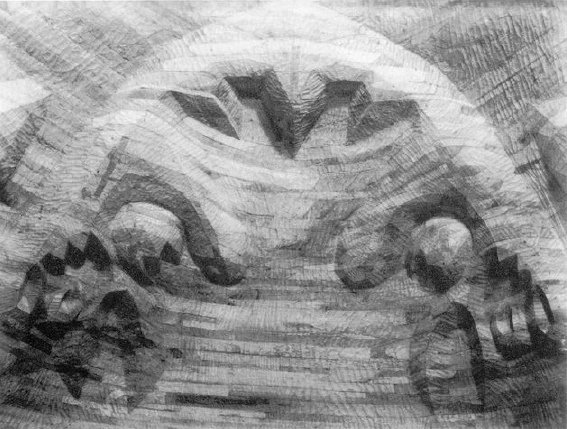
This is what you see when you enter the small domed room from the auditorium. The end of the small domed room. A number of forms have been carved out of the wood. All of them have been carved out of the rounded surface of the wood, a number of forms that are a summary of the forms found on the capitals and architraves. So that, standing in the auditorium, one has the forms of capitals and architraves, and when one looks up into the small domed space, as a conclusion to all this on a spherical surface, which is like the formal synthesis, the formal synthesis of what can be seen on the individual forms of the architraves and capitals. And now I have to move on to something about which I will have to say a few words.
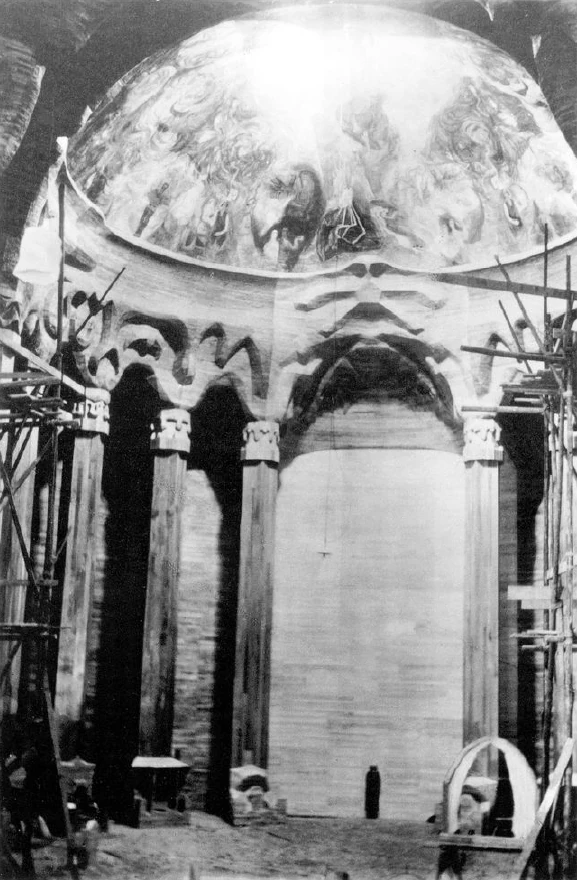
This is what the small domed room looks like when it is painted. Both domed rooms are painted with motifs that actually only arise when you live very inwardly with what we call anthroposophically oriented spiritual science. When you live very inwardly with this, then, I would like to say again, picturesqueness also emerges all by itself. Just as the word is formed by wanting to express the inner spiritual experience through the word, so this inner spiritual experience, which is truly not so poor that it could only express itself in abstract thoughts and ideas, but can express itself in everything that is a form of life and the purpose of life, is transformed. And motifs that are just as much alive in the one who lives in the inner contemplation of the spiritual world, as it is conveyed through spiritual science, are also painted in the large and small dome in such a way that one does not have the feeling of being closed off by the dome, but rather that one has the feeling, through what is painted on the wall, that the domes form themselves far out into infinity. I want to discuss, because I can't explain everything, only what is painted here in the small domed room, so that you can see it immediately when you look from the auditorium into the small domed room.
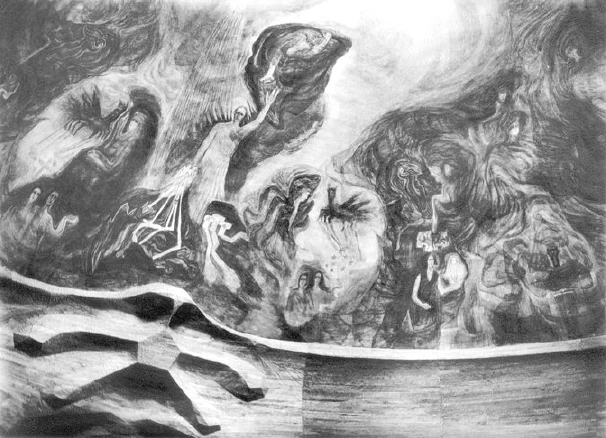
There is a central figure. It represents to me, as it were, the representative of humanity as such. At the same time, it is the artistic expression of that which lives in the human form. So that even in its natural human form, the human being must constantly seek balance between two extremes. What the human being actually is is something that should be expressed by the content of all anthroposophically oriented spiritual science. This cannot truly be said in one or even many lectures, but comes to expression in the fullness of all spiritual science. But one can say the following, which is still somewhat abstract but already points to what is experienced as human essence in the human being. One can express it in soul terms as follows:
In fact, human beings are always engaged in an inner battle between something that works in him in such a way that he wants to rise above his station. All that is fanciful, enthusiastic, mystical, theosophical, that seeks to lift man in the wrong way above himself, so that he no longer remains on the firm ground of reality, all that is one extreme. This is what some people tend towards, what every human nature secretly tends towards, and what every human nature must overcome through its health. Enthusiasm, fantasy, one-sided mysticism, one-sided theosophy, in short: everything that makes man want to rise above himself, is one thing in the soul. The other thing that is in the human soul and must be overcome through inner struggle is what constantly pulls him down to earth; expressed in spiritual terms: the philistine, the bourgeois, the materialist, the merely intellectual, the abstract, the calculating. And that is the essence of man, that he seeks to find harmony between the two opposite poles.
In physiological terms: the same thing that appears physically when a person wants to go beyond themselves is also expressed physiologically in the fact that a person can become feverish, develop pleurisy, that human nature is led into dissolution. The other extreme, that which develops in the soul as mere intellect, as narrow-mindedness, as philistinism and materialism, is what causes the ossification of human nature and leads to one-sided calcification, to ossification. Between these two physiological extremes, human nature fluctuates and seeks balance.
The intention is not to present an idea, but rather – both pictorially up there and sculpturally in the group of figures down here – to show how the representative of humanity lives in the middle between the two extremes that I have depicted. And so, above the central figure, which expresses the representative of humanity, there appears, at the top, a luciferic figure that expresses everything that is enthusiastic, fanciful, feverish, and pleurisy-ridden, etc., that wants to lead people beyond their heads. And at the bottom, protruding out of the cave, is the representative of everything ossified, everything philistine, everything that leads to sclerosis in its one-sidedness.
This central figure is designed in such a way that there is nothing aggressive about it. The left arm points upwards, the right downwards. Every effort has been made to represent love embodied in this representative of humanity, right down to the fingertips. And just as I am convinced that the trivial figure of Christ, as we usually see it, bearded, only came into being in the fifth or sixth century, so I am convinced, from spiritual scientific sources, which I can't talk about, but only because of lack of time, I am convinced that the figure that is depicted here is a real image of the one who walked in Palestine at the beginning of our era as the Christ-Jesus figure. And there should be nothing aggressive about it, even if the figure of Lucifer is painted, poetically shaped, falling and even breaking into pieces, not through an attack on the part of Christ Jesus, but because in his Luciferic nature he cannot bear the proximity of embodied love.
And if Ahriman, down there, the representative of the ossifying principle, the being that carries within itself everything that seeks to bind human beings to the earth, everything that does not want to let them go, suffers torment, ground. This is not because the figure of Christ hurls lightning bolts, but because this ahrimanic entity, through its own soul condition, so to speak, out of embodied love, casts lightning bolts for its own torment.
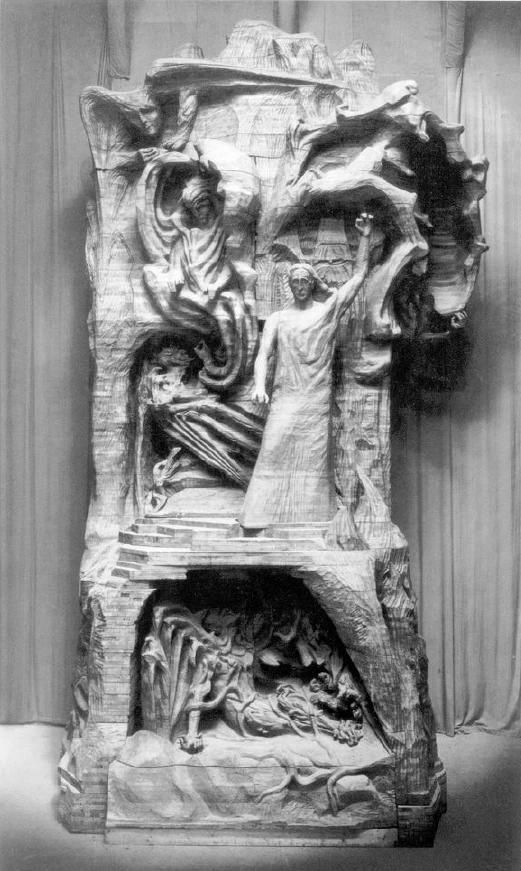
Here I really tried to depict love both plastically and pictorially in this central figure. And in a similar way, the inner experiences of spiritual science are given in the pictures on either side of this central group. But I can only show you the content of what is painted here. But that is not the main thing. In the first of my Mystery Dramas it is stated that in truth only that corresponds to modern ideas about painting in which the form of the color is the work. And here in this small dome an attempt was once made to create everything that was to be created out of color. If someone asks about the meanings, they are at most what one has tried to attach to the color scheme. I have to keep saying: one sees the color spot there or there, and what is in its vicinity as color spots, that is more important to me than what is meant there in a novelistic way.
An attempt has been made to realize this – I know all the counter-arguments – but it has been made, to realize what appears to me to be the case: I actually perceive every line in nature, when it is reproduced by drawing or painting, as a lie. The truth in nature is color. One is not concerned with the horizon line, but above with the blue firmament, below with the green sea, and where the two colors meet, the line and the form arise by themselves. This is how I have tried to paint here: everything from the color. The line should be the creature of the color.
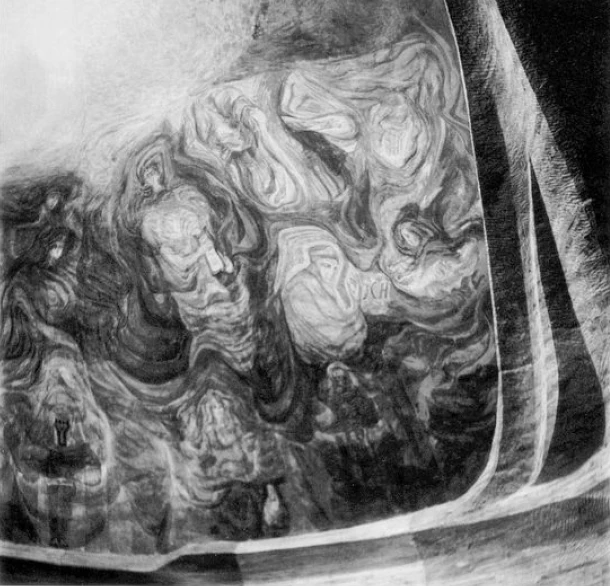
Here you can see a section of the painting more clearly.
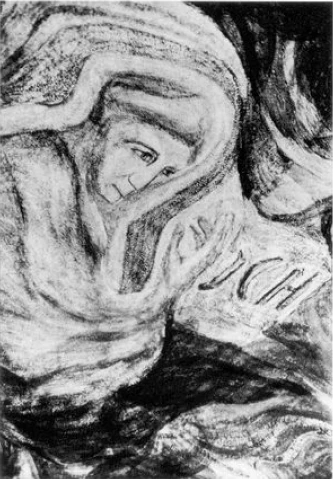
Here is a kind of rule of thumb. Here is the only word written out with letters that can be seen as a word in the whole structure. Nowhere is there anything symbolic that could be expressed in words; only here at this point, where an attempt has been made to convey the sensation as an experience through color, which occurred around the 16th century, when humanity developed more and more towards an individualistic soul life; there, knowledge took on very special forms. Those who speak of knowledge in such abstract terms, as many epistemologists do, really know nothing of the inner experience of knowledge. Today, knowledge is only known by those who can see before their soul how, in the process of limiting human life, childhood emerges from the spiritual world.
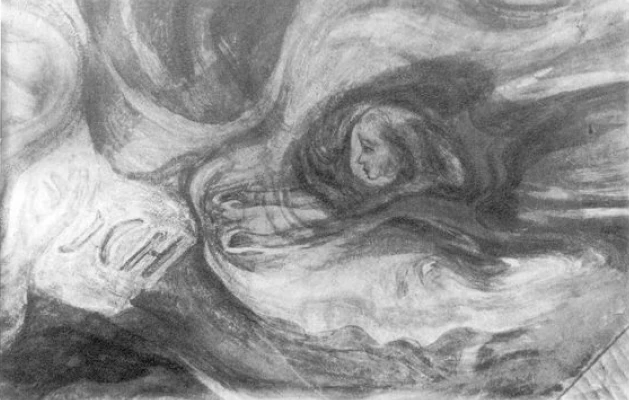
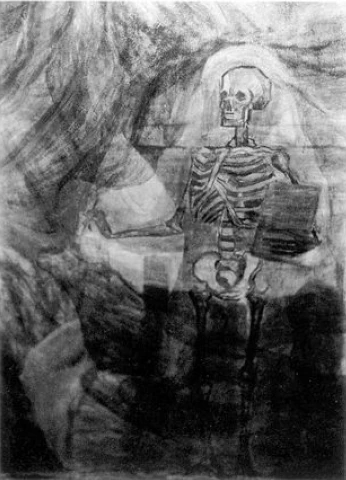
Here the child and on the other side, death. In the middle, the realization, the realization that brings it to the individualism of the ego-grasping. That which humanity has felt as actual cultural thoughts, for example in the 16th century, is attempted here to be expressed through color. I can only show you the content, which is not the main thing. But I think that precisely because this content is imperfectly depicted here, it evokes the feeling that something is still missing here, without which this thing cannot truly be what it should be. Anyone who sees this should feel that there should be color: here the child in its particularity, here the self, there a kind of fist-like figure, and below that death.
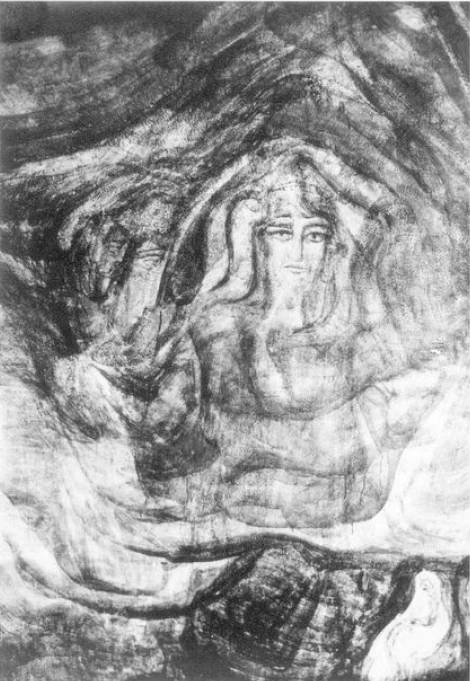
Here a little further. With the first figure we were still touching the auditorium. Here we come to the middle of the small domed room. There we have a figure that is supposed to represent how the spiritual was experienced by a cognizant human being in ancient Greece. The sensations, as they pass through human spiritual culture, should be seen in colors on the wall.
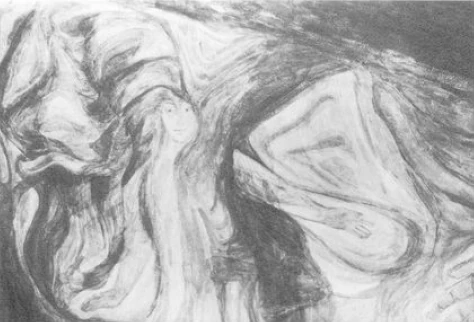
Here is the figure, which is, as it were, the inspiring figure above the Faust figure. You always see the inspired below, with a kind of genius above. Here is the genius of Faust, who appears as a kind of inspirer of Faust.
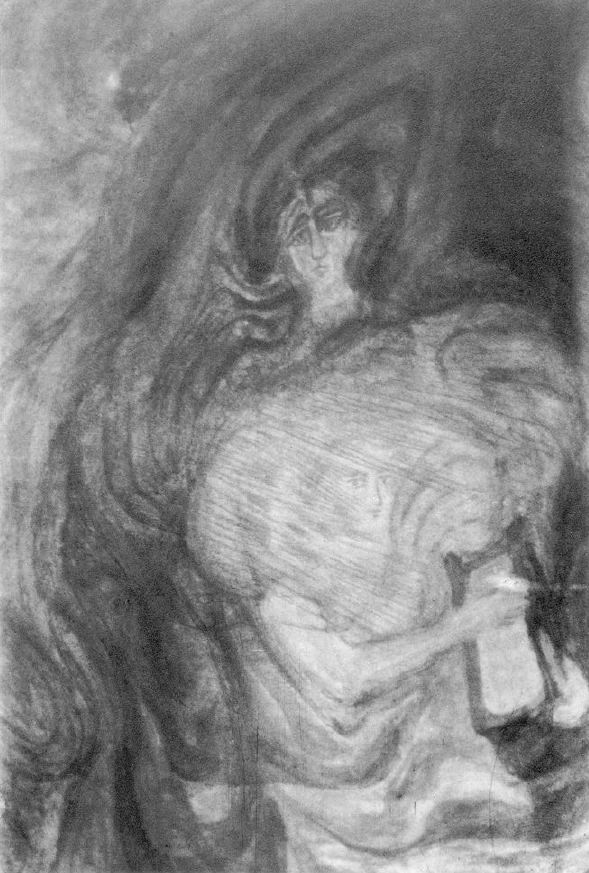
Here is the figure that can be seen above the Greek figure as an inspiring figure. It was a natural development that the genius of the sentient and cognizant entity was depicted as Apollo with the lyre. This is a higher inspiring entity that is always above the one who is down below, who is sitting down below, as it were, on the column. The inspiring figures are painted in the dome space.
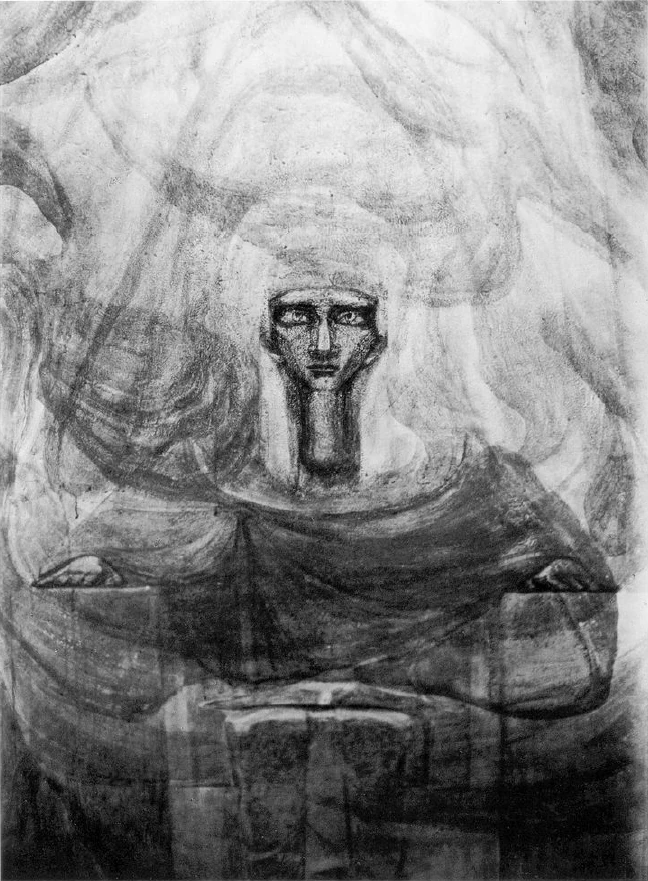
Here below is an Egyptian figure, leading the Egyptian soul-life. The two figures shown before (Fig. 75) stand above her and represent the inspirers; the entities that are meant to pour the soul-life into them. Fig. 44 (Fig. 77):
Here I have tried to show how the civilization that I would describe as that of the Persian Zarathustra culture, which dates back to primeval times and has a view of the world as dual, ambivalent, as a world in which light and darkness cast their effects, how this view of the world has spread from Asia through Central Europe, and how it is still expressed in Goetheanism, where man experiences it. That is the essence of our Germanic-German culture: we always experience this contrast between light and darkness, which is already expressed in the old Zarathustra culture, this contrast that cuts so deeply into our souls when, on the one hand, we feel something that wants to grow beyond us like light; on the other hand, something that, like heaviness, wants to pull us into the earth. This is how the dualism that is felt should be expressed.
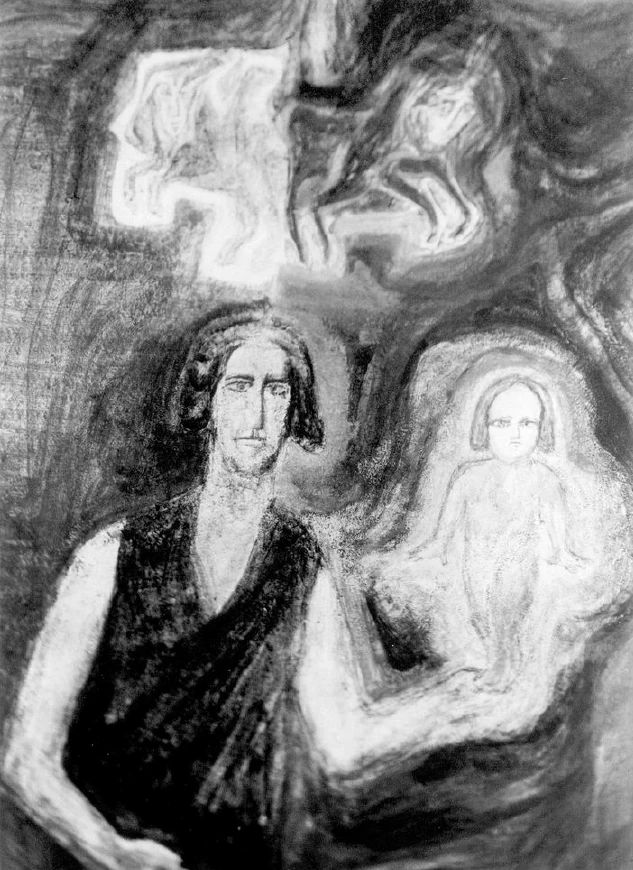
Above them you can see two figures. Sometimes you get fed up when you have been working on something like this for months. I got fed up while forming these two figures, in these figures, in which the inadequate and the ugly come to life, to recreate something like Mr. and Mrs. Wilson. That was something like a bugbear. But the other thing is that, basically, something lives in the Germanic-German soul when it experiences the thought of realization, which can only be endured if one recognizes full life in harmony with where life innocently enters physical existence from spiritual worlds.
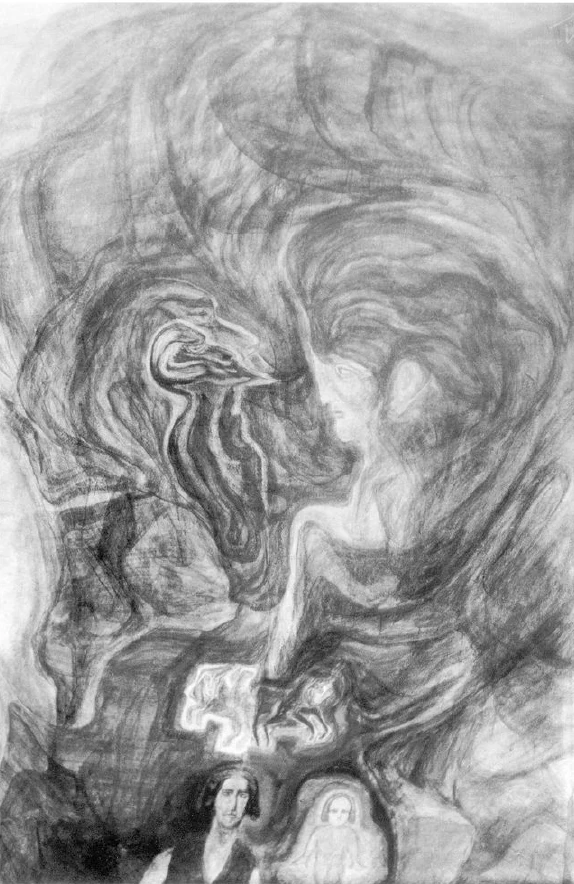
Here you have, so to speak, an inspiring summary of everything that appears as duality: the being of light, the Luciferic, that which tempts people to fall into raptures; the other is the pedantic, the philistine, the Ahrimanic, which would like to drag people down. No civilization experiences this dualism as deeply and dramatically as the one within which there is a transitional context for contexts that go back to ancient times to the Zarathustra culture and find their expression in all that has become Goetheanism, which we still feel by spiritual science itself compels us to present the representative of humanity as he must seek the balance between the Luciferic, the mystical, the enthusiastic, the theosophical, and the Ahrimanic, the pedantic, ossified, philistine, sclerotic, and so on.
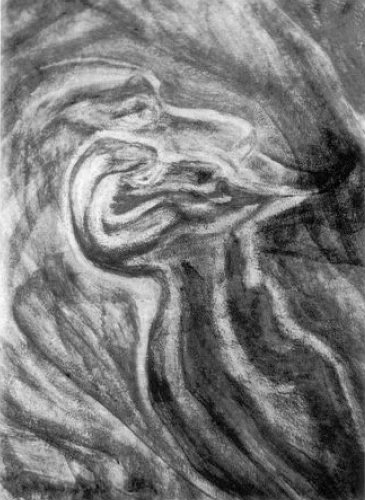
Here is the one figure, the ahrimanic, philistine, pedantic one, with the forehead set far back; the whole built as man would become if he were pure intellect. Only by the heart working its way up into the head do we avoid one extreme, how we would become if we only developed the things that form the skull, but which cannot form themselves according to their own inner forces because this is counteracted by the heart and the whole of the rest of the human being.
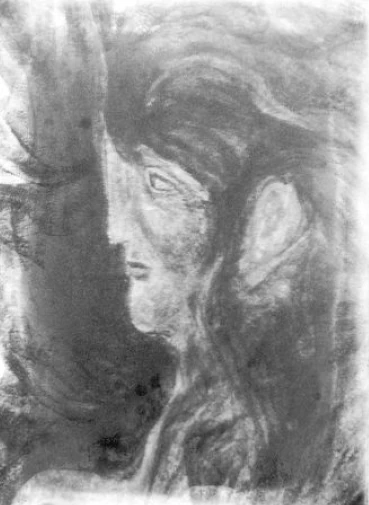
Here the other aspect, counteracting the Ahrimanic aspect. Between these two aspects, man must always seek his equilibrium. Christ is the great Master who leads us on the path to find this balance.
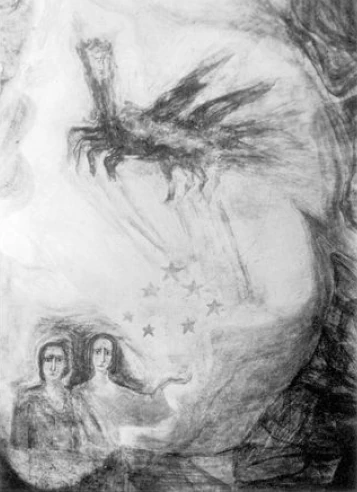
Here we come up against the central group. This is what will arise when dualism has developed to the point where the human being feels himself to be twofold, as a higher and a lower human being; that he has his shadow within himself, but as a shadow that he digests spiritually and mentally.
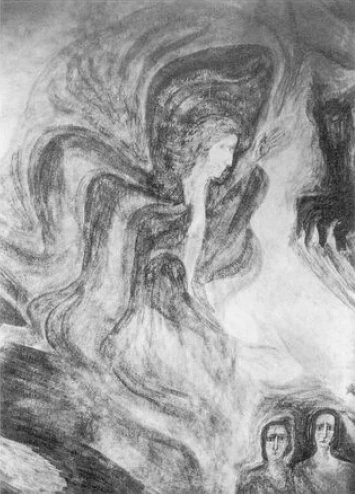
As a kindly genius that is above him.
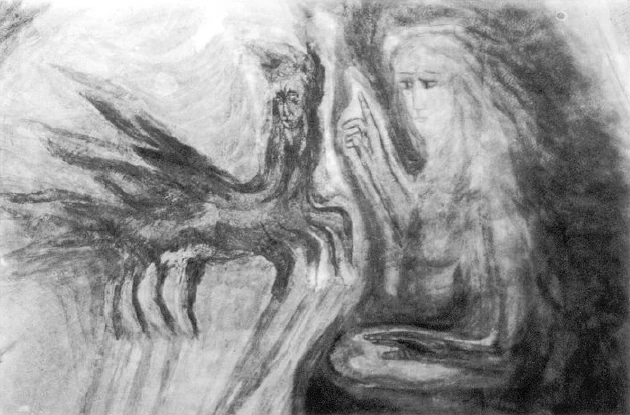
Here a centaur, inspiring him what needs to be overcome in us as animality. Up here the centaur form, inspiring a future culture, next to the genius, the angelic, what approaches man on the other side.

Here is the central figure, Christ, not by attaching a vignette to him, but by placing him as the central figure. One should feel artistically: this is the figure in which the divine has appeared on earth. One should feel it from the form, from the line, from the surfaces and here from the color.
Figure 53 (illustration unclear): Here, at this point, it has, so to speak, been completely successful, even if it is only an attempt, to create everything out of color, without line.
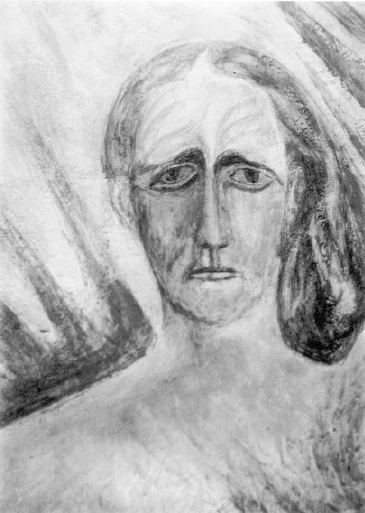
Here is the head of the Representative of Man. Above it, Luciferic; below, Ahrimanic. This is the head that appears to me, from the spiritual vision – as far as one can form it – as the true form of the one who lived in Palestine at the starting point of Christianity as the Christ.
Here is the figure of Lucifer, collapsing into himself. It is painted in red and worked out of red. Picture 56 (Fig. 86): Below, the figure of Ahriman.
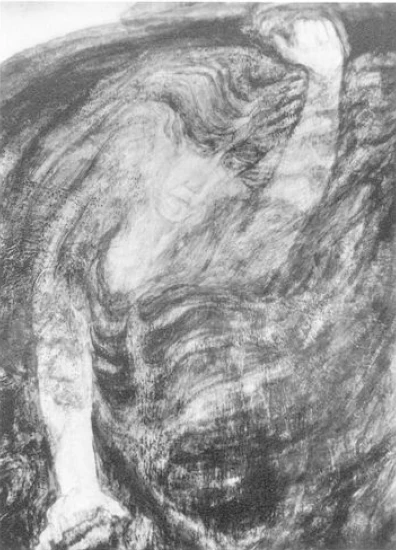
Here is the head, as the human head would be if it were not softened by the rest of the human being.
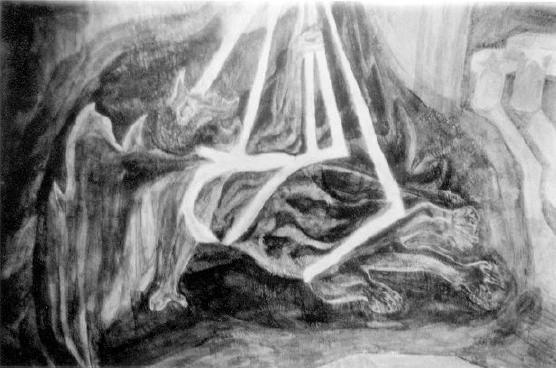
Here is the lightning bolt that must be drawn from the Christ principle.

Here I then move on to showing an illustration of a group of people. This group of people now also represents the representative of humanity. Above them are two figures, one again representing the rapturous, the mystical and so on. And as paradoxical as it may sound, this is designed in its forms as it presents itself in an inner spiritual vision if one wants to represent what man would be like if he formed himself according to the feverish, the pleuritic, the enthusiastic-fantastic.
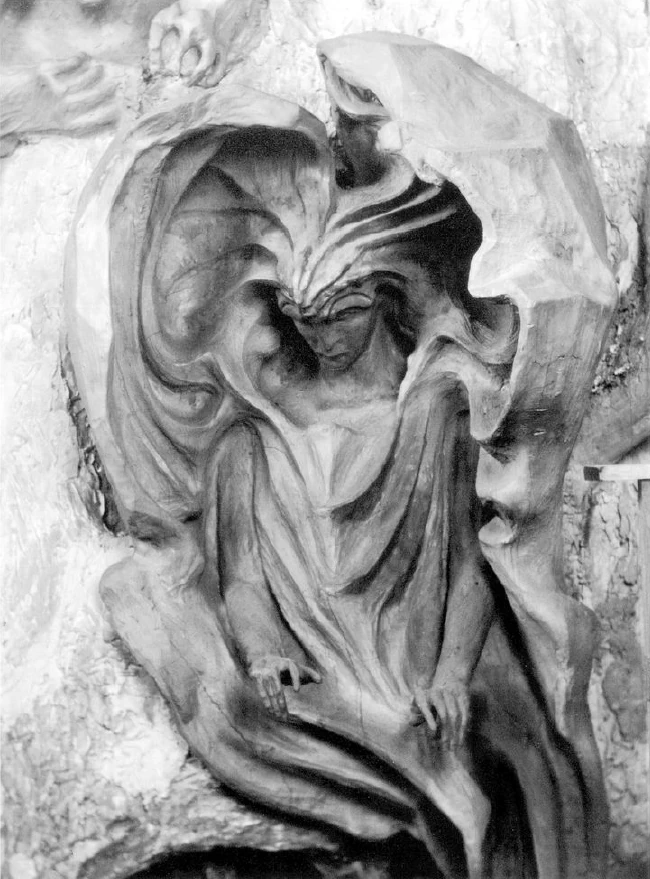
Here the head, here the arm, and the peculiar thing that arises: that the larynx, ear and chest come together and merge into the wing. You feel what becomes an expressionist work of art. This is something that the non-understanding person might call symbolic. It is not symbolic, it is observed as only an organic-physical form can be observed.
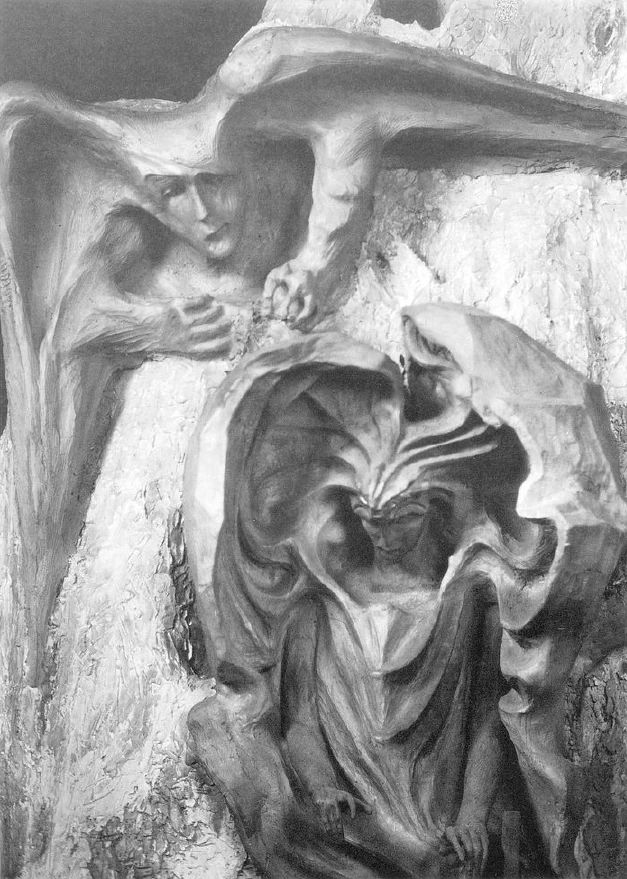
Here again this figure, and here the figure at the very top on one side of the group of wood. It turned out that we needed something purely to balance the gravity conditions so that the whole group would support itself. It became so that I had to dare to create something quite asymmetrical, a kind of elemental spirit, growing out of the rock form, but here made of wood. If you abandon yourself to the rock formations, look at them and let your imagination create, saying to yourself: nature has decided on their formation, but if they were to continue, what would arise? You end up with something that approaches the higher form but is not it. I tried to create that in this figure. Above are two luciferic figures, below two ahrimanic figures, and up there this entity, which was dared to be formed completely asymmetrical, because it occurs in a place where the symmetrical would be in contradiction to the whole, and which looks somewhat mischievously humorously at what is forming there as the human struggle. I say “mischievously humorous” because there are indeed entities in the spiritual world that look with a certain humor at the inner tragedy of the human soul struggle. Picture 62 (Fig. 94):
Here you see a photograph of my original wax model of the Ahriman figure, the Ahriman head, the original pedant, the original philistine, the head that would have formed if the other human-forming forces had not counteracted the head-forming forces. Once you have created something like this, you know that you have nothing more to add to it. If you then want to create the head for Ahriman, who lives down in the rocky cave and is in conflict with Lucifer, this head also undergoes a metamorphosis, and the place where it needs to be in the body goes through a corresponding metamorphosis.
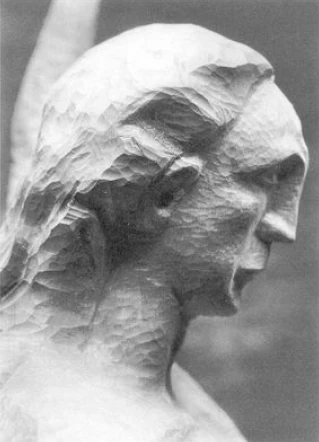
Here, seen from the side, is the head of the central figure, of whom I have just shown the painted form; that figure, carved out of wood, is, in my opinion, supposed to represent Christ Jesus walking in Palestine.
It is remarkable; while I was creating this, it became clear to me once again that one should actually create all Christian motifs in wood. The warmth of the wood – this statue is made of elm wood – is necessary for Christian motifs. An Apollo, an Athena is better in marble; Christian motifs are better in wood. It was always a real pain for me to see Michelangelo's Pieta in Rome, the mother with the body of Christ on her lap. I would have liked to see this Pieta - which I nevertheless greatly admire, of course - in wood instead of marble. I don't yet know the reasons myself. Such things cannot be easily explained. But I think the Aperçu is correct that everything Christian must be represented in wood.
Now, regarding the group that I just showed, which forms the center of the building, there is one more thing. If we follow the development of architecture, and consider only two or three stages, we must say: let us look at a Greek temple. It is not quite complete if it does not have its god inside. You cannot think of a Greek temple in general, but only of a temple of Apollo, a temple of Athena. It is the god's dwelling.
Let us move from Greek architecture to Gothic. The Gothic cathedral is not complete unless the community is within it.
We live in an age in which the community is becoming individualized. Therefore, the social question is the most important question of our time, because people live according to their individuality. Grasping the deepest nerve of our contemporary culture, we must look at what a building that belongs to a community must be a framework for today: for the people themselves. Therefore, the representative of human self-knowledge, the trinity between man, as he struggles in his soul between the enthusiastic-mystical and the pedantic-philistine, materialistic, this trinity should be placed at the center of the building, just as the god stands in the Greek temple, as the community praises in the Gothic cathedral. In this way, the spectator area should be pervaded by the pictorial and plastic sound of the “know thyself,” not in abstract forms, but artistically embodied in the Trinity of which I have so often spoken and which, in my opinion, is the Trinity of the culture of the future of humanity. Therefore, this wooden figure did not have to be erected at the center of the building, but as the central figure of the building.
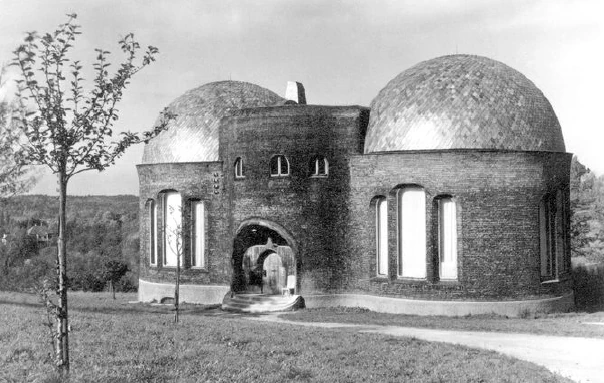
Here an adjoining building, a neighboring building. Again a metamorphosis of the two domes. Here the architectural idea has been developed into a different form. The main building has windows for which a special type of glasswork has been invented. What I said earlier – that those inside this building feel at one with the whole universe, not closed off – should be expressed through the windows. That is why all the windows are large panes of glass in a single color. These panes – red, green, blue – are engraved, etched out of the glass, which then gives the glass its visual effect. This visual effect is there when the sun shines through the windows. This glass etching was tried for the first time in this building. And here, with the glass window in front of you without sunlight, you can physically feel a kind of score; together with the sun, it becomes a work of art. And you feel in the building: when the sunlight floods in through red, green, and blue panes, what the sun paints with its light lives in these windows, so that it is a representation of human death, sleep, waking, and so on; but nowhere is it symbolic, rather these states of consciousness are experienced vividly within.
These glass windows were to be made in this smaller building. And because the first person to work there was called Taddäus Rychter, this house was called “the Richter house”. So it does not have this name because we want to implement the threefold social order, as some people have said, and so we would have built a legal building in which we would have had our own jurisdiction. That is not the case. This should be noted by those who have done something wrong; they will be convicted according to Swiss law.
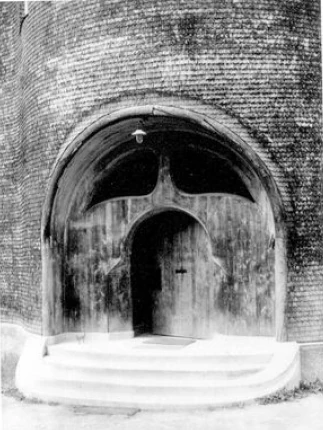
This is the entrance gate. Everything about it, down to the locks and door handles, is designed in line with the organic architectural concept, so that everything has to be the way it is in its place. Hence the need for a separate lock for these structures.
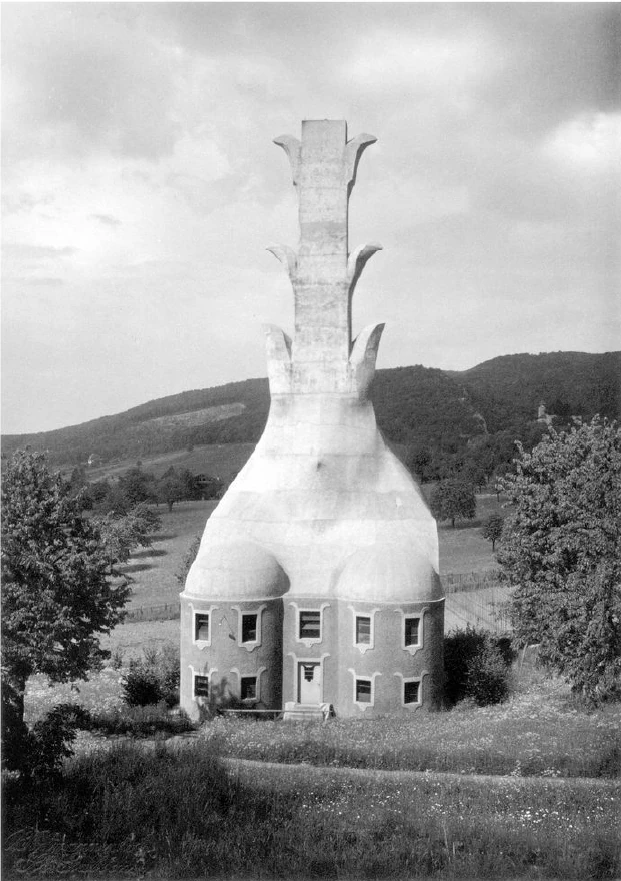
Here you can see the one that has experienced the most challenges. One day I said to myself: there must be a heating house, a firing plant, near the building. One could have done something that would not have been in the spirit of the overall architectural concept of the Goetheanum; a red chimney would have stood there. But I tried to create a utilitarian building out of concrete. I tried, in turn, to form a shell around the heating elements and the firing machines that are inside, just as the nut fruit forms a shell around itself. Also around what comes out as smoke. The whole is only complete when smoke comes out. So there, too, an attempt is made to carry out a building idea in such a way that, despite the utilitarian idea being carried out, what is created out of the utilitarian form is that which, in utilitarian building, the artistic form-giver currently strives for.
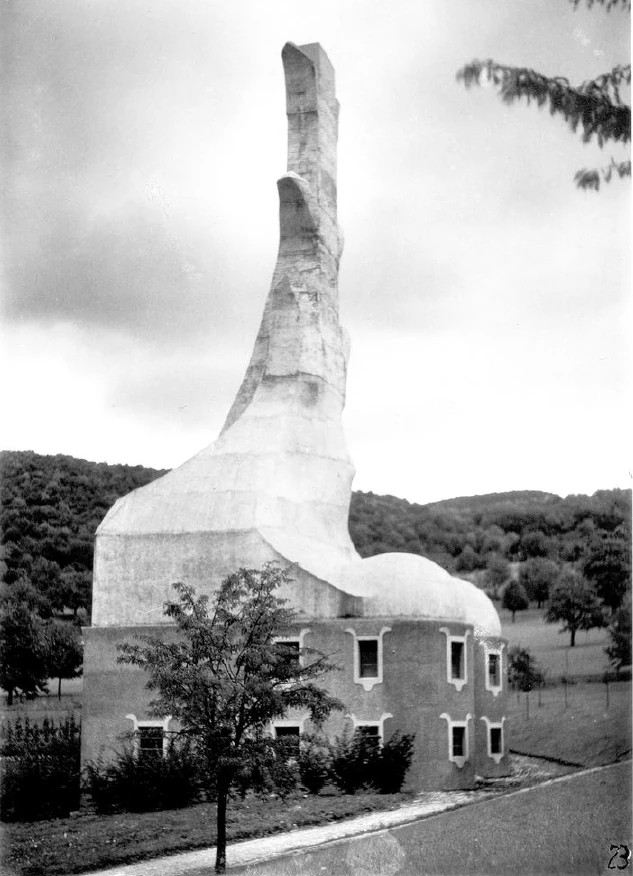
The same building from the side.
By now, enough time has passed and I have kept you waiting for a long time with a large number of pictures that were intended to show you something that is being built in Dornach as the Goetheanum, as a free university for spiritual science. What I have shown you in a series of pictures is intended to provide an initial framework for the work that has arisen from the spirit of spiritual science, which I have now been able to present in Stuttgart for almost two decades. A building was to be erected in Dornach that would not only have an external connection to this spiritual science, in that it serves the cultivation of spiritual science, but that would also be an expression in every detail of life in this spiritual science, just as the word that is formed and through which this spiritual science is proclaimed is intended to be a direct expression of the ideal that can be experienced in this spiritual science.
This spiritual science should not be abstract, theoretical, unworldly or unreal. This spiritual science should be able to intervene in reality everywhere. Therefore, it had to create a building style, a framework that emerged from itself just as a nutshell emerges from a nut. Of course, one will rightly be able to object to some things that are also before my mind's eye. But there was always a certain sense of encouragement while I was working on this building idea and all its details, what went through my mind when I was a very young man in the 1880s and heard the Viennese architect von Ferstel, who built the Viennese Votivkirche, give his inaugural address on the development of architectural styles. With a certain emphasis, Ferstel, the great architect, exclaimed: “Architectural styles are not invented, architectural styles arise.
I always said to myself: But then we live today in a time in which everything spiritual must change in the human soul in such a way that a new architectural style must necessarily arise from this change of the spiritual. And that something like this must be possible was always before me. I believed that it must be possible, and therefore I did not shrink from seeking such an architectural style, even if it was initially in a very imperfect design, from anthroposophically oriented spiritual science. A second time, if I were ever to supervise such a building again, it would be quite different. But one only learns by approaching reality, when one wants to deal not with abstract ideas, with something symbolic and allegorical, but with something vividly artistic and real in life. Spiritual science needs at least the beginning of a new architectural style, a new artistic formal language. No matter how imperfect it may be, present-day human civilization demands it! And those who have stood by me in such great numbers have seen it with me and have submitted to the first attempt at realizing this aspiration. And even if many still look with a sneer at what rises up as the Goetheanum, as a free college on the Jura hill in northwestern Switzerland — which is now difficult to reach from here, but otherwise easy to reach because it is only half an hour across the border — what stands there is already visited by thousands and thousands from all countries, especially from Switzerland itself. The eurythmy performances are also well attended, every Saturday and Sunday, and the lectures that I already give for the public in this school enjoy a certain interest even in circles that do not belong to the Anthroposophical Society. Dornach is beginning to open up to the world. It will still cost great sacrifices. We will still need many resources to really develop what is intended. But from what is there today, what is still unfinished, it can be seen that there can be a world view that not only thinks but also builds. On the other hand, we would like to show the world through the Federation for Threefolding that this world view can also have a socially constructive effect on the immediate life of the individual and of humanity. However great the faults of this structure, which is the external representative of our world view, our spiritual-scientific world view, and however much it is still rightly subject to criticism today, it had to be ventured. It had to be placed in our present civilization. And in the face of all contradictions - or rather in the face of all approval of the present - I would like to say, in harmony with all the friends who have helped me in such great numbers in erecting this building, in the face of what is intended here, the modest, summarizing word:
What has been willed must first become the right thing in later times, but a start had to be made. And speaking on behalf of all those who have been active in Dornach, I can summarize the attitude out of which flowed what I have tried to show you today: we dared to do it despite the difficulties, and we will continue to dare to do it!
Das Goetheanum in Dornach
Öffentlicher Vortrag im Stuttgarter Kunstgebäude
Als die Geisteswissenschaft, über deren Ziele und Wesen ich ja nun auch schon seit fast zwei Jahrzehnten jedes Jahr in Stuttgart Vorträge halten durfte, eine größere Ausbreitung gewann, namentlich als aus dieser Geisteswissenschaft heraus künstlerisches Schaffen sich gestaltete, da entstand die Absicht, irgendwo, wo es angemessen sein sollte, für diese Geisteswissenschaft einen ihr besonders entsprechenden Zentralbau zu schaffen. Die Idee hat sich insbesondere dadurch zu einer gewissen Realität verdichtet, dass wir in den Jahren 1909 bis 1913 in München in einem gewöhnlichen Theater aufzuführen hatten Mysteriendramen, welche in ihrem ganzen Aufbau, in ihrer ganzen Haltung herausgeboren sein sollten aus dem Geiste dieser anthroposophisch orientierten Geisteswissenschaft.
Dasjenige, was den Trägern dieser Geisteswissenschaft vorschwebte auf der einen Seite als der eigentliche Sinn ihrer Weltanschauung, was ihnen vorschwebte andererseits als künstlerische Ausgestaltung dieser Weltanschauung, das brachte zunächst die eben angedeutete Absicht, einen eigenen Bau aufzuführen, der der Repräsentant sein sollte, der äußerliche Repräsentant für diese Geisteswissenschaft. In München ist es wegen des geringen Entgegenkommens der maßgebenden Künstlerschaft nicht gelungen. Da ich mir heute eine andere Aufgabe gestellt habe, so möchte ich nicht sprechen über alles das, was dann dazu geführt hat, auf einem in freier Lage stehenden Hügel im Nordwesten der Schweiz im Kanton Solothurn diesen Bau aufzuführen, wo es damals, als wir zu bauen begannen, noch keine beengenden Baugesetze gab, sondern wo man bauen konnte, wie man wollte. Was alles, wie gesagt, dazu geführt hat, das will ich heute nicht erst auseinandersetzen. Doch möchte ich aber davon sprechen, in welchem Sinne die Absicht aufgefasst werden müsste, gerade für die hier gemeinte Geisteswissenschaft einen Bau zu gestalten.
Wenn man sonst von Weltanschauungen, von Weltanschauungsrichtungen oder Weltanschauungsströmungen spricht, dann hat man gewöhnlich im Auge eine Summe von Ideen, die oftmals einen mehr oder weniger theoretischen oder populären Charakter tragen, die aber doch zumeist sich darin erschöpfen, dass sie sich eben ideenhaft durch Mitteilung, durch das bloße Wort aussprechen wollen, und dann höchstens von der Welt erwarten, dass das Wort, das in einer gewissen Weise programmmäßig gestaltet wird, in Wirklichkeit übergeführt werde. Dasjenige, was hier gemeint ist als anthroposophisch orientierte Geisteswissenschaft, ist von vornherein nicht so veranlagt wie andere Weltanschauungen. Es ist, wenn ich mich so ausdrücken darf, vom Anfang bis zum Ende durchdrungen von Wirklichkeitssinn. Deshalb musste es ja auch in schwerer Zeit in dieser Gegenwart dazu führen, unmittelbar einzudringen in dasjenige, was der Versuch eines sozialen Neuaufbaues der modernen Zivilisation ist. Wenn nun eine Weltanschauung, die sich mehr im Ideenhaften hält, einen eigenen Bau zu ihrer Pflege braucht, dann setzt man sich in der Regel in Verbindung, je nachdem man viele oder wenig Mittel hat, mit irgendjemandem, von dem man voraussetzt, dass er fachgemäß aus den maßgebenden Stilrichtungen heraus in der Lage ist, einen Bau aufzuführen. Man setzt sich mit einer solchen Personlichkeit oder mit einer Reihe von solchen Persönlichkeiten in Verbindung, um dann gewissermaßen ein Haus, eine Umrahmung für die Pflege einer solchen Weltanschauung zu schaffen. Der ganzen Anlage unserer anthroposophisch orientierten Geisteswissenschaft hätte das aber nicht entsprechen können, aus dem einfachen Grunde nicht, weil eben diese Geisteswissenschaft nicht etwas ist, was sich nur in Ideen ausdrückt, sondern weil sie sich ausdrücken will in allen Lebensformen.
Nun möchte ich einen einfachen Vergleich gebrauchen, um anzudeuten, wie gerade baumäßig und künstlerisch sich ausdrücken musste in ihrer eigenen Umrahmung diese anthroposophisch orientierte Geisteswissenschaft. Nehmen Sie irgendeine Frucht, sagen wir die Nuss. Die Nuss ist innen Frucht, rundherum hat sie eine Schale. Ich will zunächst die harte Schale innerhalb der grünen Schale betrachten. Wenn Sie die ganze Konfiguration, die Gestaltung der Nussschale studieren, so werden Sie sich sagen: Die könnte nicht anders sein, als sie ist, da die Nuss so ist, wie sie ist. Man kann nicht anders als sich denken: Die Nuss schafft sich ihre Schale, und alles, was an geringsten Kleinigkeiten von der Schale sichtbarlich ist, das muss ein Ausdruck sein desjenigen, was die Nussfrucht selber ist. So ist eine Umrahmung ganz angemessen in der Natur, in allem Geschöpflichen dem, wofür sie Umrahmung ist.
Denkt man nun nicht abstrakt, denkt man nicht theoretisch, denkt man nicht aus einer Weltanschauung, die sich bloß in Ideen bewegt, sondern die in aller Wirklichkeit und in allem Leben drinnen stehen will, dann fühlt man sich gezwungen, alles, was sie tut, in einer gewissen Beziehung auch so zu tun, wie es die schöpferischen Kräfte im Weltenall tun. Und so wäre denn, wenn man mit irgendeinem fremdartigen Baustil, mit irgendetwas, was herausgewachsen wäre aus jenen Bauweisen, die heute einmal üblich sind, gebaut hätte eine Umrahmung für anthroposophisch-orientierte Weltanschauung und ihre Pflege, es wäre dagewesen zweierlei: auf der einen Seite ein Bau, der sich ganz aus sich heraus ausspricht, der für sich etwas sagt, der in seiner eigenen künstlerischen Formensprache dasteht. Und dann wäre man hineingegangen und hätte drinnen etwas vertreten, etwas gepflegt, was eigentlich nur in einer ganz äußerlichen Weise selbstverständlich zu diesem Bau stehen könnte. Man würde Worte hören in einem solchen Bau, man würde Bühnenspiele betrachten (da diese ja beabsichtigt sind) und anderes Künstlerische aufgeführt sehen; man würde - ich habe ja darüber öfter gesprochen, und auch während dieses meines Stuttgarter Aufenthaltes spreche ich in drei Vorträgen über das Wesen dieser Geisteswissenschaft - man würde etwas gehört, etwas gesehen und erschaut haben, was als ein Neues sich hereinstellen will in die moderne Zivilisation. Man hätte dann das Auge hinweggewendet von dem, was man vielleicht auf der Bühne gesehen hätte; man hätte das Ohr abgewendet von dem, was man gehört hätte, und man hätte die Bauformen ins Auge gefasst - das wären zwei voneinander wesensverschiedene Dinge geworden. So konnte die hier gemeinte Geisteswissenschaft gar nicht streben. Sie musste streben im Einklang mit allem Weltenschaffen. Sie musste sich zugetrauen, ebenso wie sie sich ausspricht in Ideen, sich auszusprechen in künstlerischen, auch in Bauformen. Sie musste Anspruch darauf machen, dass dasjenige, was zum Worte sich bildet, was zum Drama oder zu einer anderen künstlerischen Ausdrucksart sich bildet, auch fähig ist, sich unmittelbar hineinzugestalten in alle Einzelheiten desjenigen, was nun die Schale ist. So wie die Nussfrucht sich ihre Schale schafft aus ihrer eigenen Wesenheit heraus, so musste eine solche Geisteswissenschaft, deren Wesen ja heute in weitesten Kreisen, weil sie eben gerade diesen Wirklichkeitsgeist atmet, nicht begriffen wird, so musste gerade eine solche Weltanschauungsrichtung sich ihre eigene Umrahmung schaffen. Alles das, was das Auge da sieht in dieser Umrahmung, musste ebenso ein unmittelbarer Ausdruck desjenigen sein, was als lebendiges Leben vorhanden ist in dieser Weltanschauung, wie das gebildete Wort.
Und es waren manche Klippen dabei zu umgehen. Denn diejenigen, die eine gewisse Neigung haben, einen Bau angemessen zu machen einer Weltanschauung, die sind oftmals, nun sagen wir einmal, etwas mystischer oder sonst wie veranlagter Natur, und sie haben dann den Drang, das, was sich in der Weltanschauung ausdrückt, in äußeren Symbolen, in irgendwelchen mystischen Gestaltungen zum Ausdruck zu bringen. Das führt aber lediglich dazu, eine solche Umrahmung zu etwas im eminentesten Sinne Unkünstlerischem zu machen. Und hätte man einen Symbole tragenden Bau aufgeführt, hätte man dasjenige ausdrücken wollen in allegorischer oder symbolischer Form, was der anthroposophisch-orientierten Geisteswissenschaft zugrunde liegt, so wäre nichts anderes entstanden als etwas im eminentesten Sinne Unkünstlerisches.
Ja, ich muss sogar gestehen, dass gar manche, die mit ihren Anschauungen, mit ihren Lebensströmungen eingelaufen sind in dasjenige, was hier anthroposophisch orientierte Geisteswissenschaft genannt wird, als Mitwirkende auch oder Mitratende, im Beginne unseres Bauens in Dornach durchaus die Neigung hatten, zum Ausdruck zu bringen alles dasjenige, was Geisteswissenschaft enthält in alten symbolischen oder dergleichen Formen. Ich darf vielleicht auch erwähnen, dass diejenigen Menschen, die ja so zahlreich sind, die entweder aus einem gewissen Unverstand oder auch aus böswilliger Absicht heraus über den Dornacher Bau reden, immer wieder der Welt kommen damit, da finde man für das oder jenes Symbole, da finde man allegorische Ausdrücke für das oder jenes.
Nun, meine sehr verehrten Anwesenden, es wird zugegeben werden müssen, dass auch in dem, was ich Ihnen heute Abend vorzuführen habe, derjenige, der nicht genau und nicht mit lebendiger Empfindung zuschaut, etwas finden kann, wovon er den Ausdruck gebrauchen kann: Da ist manches allegorisch oder symbolisch gemeint. In Wirklichkeit ist im Dornacher Bau kein einziges Symbol, keine einzige Allegorie, sondern alles das, was da vorhanden ist, das ist durchaus so, dass das innerliche Erleben des Geistes, wie er auf der einen Seite gefasst werden soll in Ideen, die in Vorträgen oder dergleichen zum Ausdruck kommen, dass dieses innerliche Erleben ganz in künstlerische Formen aufgelöst sein soll, dass nichts anderes gefragt wird beim künstlerischen Schaffen in Dornach als: wie die Linie ist, wie die Form ist, wie dasjenige ist, was sich als künstlerische Ausdrucksform eben in der Plastik, in der Architektur, in der Malerei usw. gestalten lässt. Und gar mancher, der da kommt in Dornach und fragt, was bedeutet das oder jenes, der bekommt von mir immer wieder und wiederum die Auskunft: Ich bitte, die Sachen anzuschauen; es bedeutet alles nichts anderes im Grunde als dasjenige, was in das Auge einfließt. Es handelt sich oftmals darum, dass die Leute sagen: Das bedeutet dieses oder jenes. Ich aber bin dann genötigt, ihnen von der Farbenverteilung und dergleichen zu sprechen.
Nun habe ich versucht darzustellen, wie gewissermaßen als eine Schale, ganz im Sinne des Naturschaffens selber, der Bau die Umrahmung für anthroposophisch orientierte Geistes wissenschaft bildet. Gerade deshalb aber musste im Grunde genommen der ganze Baugedanke auch nach etwas Neuem streben. Nun bitte ich, bei alledem, was ich heute sagen werde, zu berücksichtigen, dass ja selbstverständlich viel Kritik geübt werden kann an dem Dornacher Bau, dass vieles eingewendet werden kann. Und ich gebe Ihnen die Versicherung: Derjenige, der vielleicht am allermeisten einwendet, der bin ich selber. Denn ich bin mir vollkommen bewusst, dass der Dornacher Bau ein Anfang ist; dass der Dornacher Bau als ein erster Versuch dasteht, eine gewisse Stilform zu schaffen, die heute noch gar nicht einmal in Worten irgendwie charakterisiert werden kann, weil ihre Einzelheiten nicht aus abstrakten Gedanken heraus gebildet sind, sondern aus dem, was lebendig erlebt wird in jenem Schauen des Geistes, das mit unserer Geisteswissenschaft gemeint ist.
Nur einen gewissen Unterschied darf ich von vorneherein angeben: Wenn wir die verschiedenen Baustile überschen, welche in einer gewissen Formentwicklung auch heute da, wo man baut, eben ihren Ausdruck finden, dann zeigt sich allüberall, dass im Grunde genommen in die Architektur einfließt das Mathematische, das Geometrische, das Symmetrische, dasjenige, was vielleicht im Rhythmus der Linie nach verläuft, das Mechanische, das Dynamische usw. Aus dem Grundempfinden - ich sage nicht aus dem Grundgedanken, ich sage aus dem Grundempfinden - unserer Geisteswissenschaft heraus wurde einmal der, ich weiß es, gewagte Versuch gemacht, einen organischen Baugedanken zu gestalten, nicht einen mechanisch-dynamischen, sondern einen organischen Baugedanken zu gestalten, und zwar unter dem Einfluss desjenigen, was Goethe seiner großen, gewaltigen Naturanschauung einverleibt hat unter dem Einfluss des Metamorphosengedankens. Dasjenige, was der Dornacher Bau ist, soll, soweit es in der Architektur sich verwirklichen lässt, nicht bloß Symmetrisches, Dynamisches, Mechanisches, Geometrisches darstellen, es soll darstellen etwas, was angeschaut werden kann, ich sage nicht aufgefasst, sondern angeschaut werden kann als ein Bauorganismus, als die Form für etwas Lebendiges.
Da handelt es sich dann allerdings darum, dass in einem Organismus jede Einzelheit so ist, wie sie an ihrem Orte gerade sein muss. Sie können sich an einem menschlichen Organismus das Ohrläppchen nicht anders gestaltet denken, als es ist. So wurde versucht, dass unser Dornacher Bau eine vollständig organische, innerlich organische Einheit ist, indem wir jeden einzelnen Teil in das Ganze so hineinstellten, dass er an seinem Ort als ein notwendiges Gebilde erscheint; dass jede Einzelheit so ein Ausdruck ist des Ganzen wie eine Fingerspitze ‚oder ein Ohrläppchen ein Ausdruck ist für den ganzen menschlichen Organismus.
Das ist das eine, was versucht wurde. Wie gesagt, es ist ein Anfang, ein Versuch, und ich weiß, wie viele Unvollkommenheiten er hat, und wie viel einzuwenden ist vom Standpunkt der architektonischen und Bildhauerkunst und so weiter. Das andere ist, was ich vorausschicken möchte, dass verlangt wurde von unserer Weltanschauung selbst, den ganzen Baugedanken anders zu gestalten, als der Baugedanke gewöhnlich gestaltet ist. Wenn wir nämlich die gewöhnlichen Bauwerke ins Auge fassen - ich will nur das eine erwähnen -, so finden wir sie auch nach außen von Wänden abgeschlossen, bis zu einem gewissen Grade. Sogar die griechischen Bauten waren abgeschlossen bis zu einem gewissen Grade. Dasjenige nun, was der Dornacher Bau ist, das erfordert, dass schon die Wand in einer ganz anderen Weise behandelt werde, als sie sonst behandelt wird. Derjenige, der den Dornacher Bau betritt, soll, indem er eine Wandung um sich hat, nicht das Gefühl haben, er sei da abgeschlossen in einen inneren Raum. Sondern alles soll künstlerisch so gestaltet sein, dass gewissermaßen die Wand sich selbst aufhebt; dass die Wand selber - ich bitte mich nicht misszuverstehen - die Wand selber künstlerisch durchsichtig werde, sodass man das Gefühl bekommt - durchsichtig ist natürlich nur im Vergleich gesprochen -, man sei nicht abgeschlossen, sondern alles dasjenige, was Wand ist, was Kuppel ist, eröffne einem die Empfindung, dass es durchbrochen ist, dass es sich selber aufhebt, dass man mit dem ganzen großen Weltenall in einer empfindungsgemäßen Verbindung stehe. Weit hinaus in die Unendlichkeiten soll die Seele sich diesem verbunden fühlen durch dasjenige, was die Formen hervorrufen; die Formen der Säulen, der Wandung, die Formen der Kuppelmalerei usw.
Meine sehr verehrten Anwesenden, der Dornacher Bau ist ein Doppelkuppelbau, sodass er besteht aus einem kleinen und einem großen Kuppelraum, die nicht nebeneinander stehen, sondern ineinandergreifen. Der kleine Kuppelraum, also jener Raum, der kreisförmig ist und von einer kleineren Kuppel überdeckt wird, der wird dienen zur Darstellung von Mysteriendramen, von Dramatischem überhaupt, von anderen künstlerischen, z.B. von eurythmischen Darstellungen. Aber auch durchaus andere Dinge sind da noch geplant. Dann der große Kuppelraum, der sich im Kreissegment der Kuppel anschließt an den kleineren. Er ist als ein Zuschauerraum gedacht; sodass denjenigen, der sich nähert diesem Bau, sogleich durch diese äußere Form eine gewisse Empfindung beschleichen muss.
Wir werden beginnen damit, dass wir ins Auge fassen unseren Bau, wie er sich etwa demjenigen darbietet, der sich ihm von Nordost her nähert.

Es handelt sich also darum, dass wir einen Doppelkuppelbau haben. Dieses ist der Zuschauerraum, hier der Bühnenraum. Hier sind die zwei Kuppeln ineinandergefügt durch, wie ich sagen darf, ein besonderes technisches Kunststück; denn diese Ineinanderfügung war schwierig. Es soll demjenigen, der sich diesem Bau nähert — der, wie ich glaube, auch ganz besonders angemessen ist in seiner künstlerischen Ausdrucksform der besonderen Gebirgsformation jenes Jura-Gebietes, in dem er errichtet ist —, es soll den, der sich diesem Bau nähert, die Empfindung beschleichen: Da ist etwas vorhanden, was sich in einer Zweiheit offenbart. Derjenige, der den Bau betritt, befindet sich im großen Kuppelraum. Darinnen kann er das Gefühl haben: Hier wird etwas geschaut, etwas gehört. Und dieses Etwas, was gewissermaßen in den Höhen des geistigen Lebens erfahren wird, das sich offenbaren soll einer geneigten Zuschauermenge, das soll sich schon als Empfindung demjenigen ausdrücken, der sich dem Bau nähert,
Alles Einzelne aber ist zunächst in den Außenformen auf das abgestimmt, dass man gewissermaßen - ich könnte es nicht durch Ideen, durch Gedanken ausdrücken -, dass man gewissermaßen durch die Formen, durch die künstlerischen Sprachformen durchaus von außen den Eindruck hat für das, was im Innern eigentlich als Geisteswissenschaft verkündet wird. Ich möchte Ihnen nun noch einen Zugang zeigen zum Bau, der sich bietet, wenn man sich ihm von Norden aus nähert:

Hier ist der Bau, hier der Haupteingang, hier ein Gebäude in der Nähe, das ganz besondere Anfechtungen erfahren hat. Ich möchte bei diesem Bilde nur erwähnen: Der Bau ist in seinem unteren Teil ein Betonbau. Hier hat er einen Umgang. Auf dem Betonrundbau steht der ganze Bau auf. Der ganze Doppelkuppelbau ist ein Holzbau.
Ich bemerke, dass ja nicht bloß die Aufgabe vorlag, der Geisteswissenschaft eine Schale zu schaffen in diesem Bau, sondern dass auch noch die andere Aufgabe vorlag, für diese ganz besondere Einrichtung nun eine Stilform zu finden, die sich aus dem Beton heraus ergeben könne. Das ist dasjenige, meine sehr verehrten Anwesenden, wofür in der Gegenwart eigentlich nicht allzu viel Verständnis vorliegt, dass überall aus dem Material heraus geschaffen werden muss. Wir sehen heute, wie Bildhauer Dinge schaffen, die sie gestalten, ich möchte sagen, indem sie irgendeine novellistische Idee oder einen novellistischen IdeenZusammenklang haben, die dann in jedem beliebigen Material, in Bronze oder dergleichen, gestaltet werden. Wir müssen aber wiederum dazu kommen, ein so intensives Materialgefühl zu haben, dass wir selbst gegenüber diesem spröden, ich meine künstlerisch spröden, diesem abstrakten Betonmaterial die Möglichkeit gewinnen, aus dem Material heraus Gestaltungsformen zu schaffen.
Es ist schon so, dass man heute schwer verstanden wird, wenn einem jemand sagt: Ich werde ein Bild malen; in der Mitte habe ich diese oder jene Gestalt, an den Seiten diese oder jene Gestalt, das will ich nun machen, kann man so etwas machen? Und man antwortet ihm: Ja, machen kann man alles, es handelt sich aber darum, was da aus den Farben wird. Man kann gar nicht über ein Bild anders sprechen als aus den Farben heraus. Es wird heute schon selbst auf vielen künstlerischen Seiten wenig verstanden, wenn man so versucht, dasjenige, was künstlerisch lebt, ganz fern zu denken von allem, was nicht unmittelbare Anschauung, unmittelbares Empfindungserleben ist.

Als drittes Bild möchte ich Ihnen vorführen einen anderen Aspekt des Baues. Sie sehen hier die kleine Kuppel, die große Kuppel. Hier von außen gesehen den Zuschauerraum. Das Ganze sitzt hier auf dem Betonunterbau auf. Hier sind Seitentrakte, die sich gerade dem Bau an der Stelle einfügen, wo die beiden Kuppeln ineinandergehen.

Dies ist der Bau etwas mehr von der Nähe gesehen. Man wird hier unten hineingehen. In dem Betonunterbau sind die Garderoben. Hier vorne im Innern ist ein Treppenhaus, ein Aufstieg. Man kommt hier oben heraus schon in den Holzbau, aber man kann auch hier, wo ein Umgang ist, herauskommen, Hier kann man um einen großen Teil des Baues herumgehen in den Zwischenpausen der Darbietungen.

Hier ist der Haupteingang von der Terrasse aus. Sie sehen hier schon, dass alle Formen aus dem Dynamisch-Geometrischen umgesetzt sind in das Organische, in das Lebendige. Es gibt in diesem Bau nichts, was nicht eben in dem Geiste geschaffen ist, wie ich es vorhin mit der Gestaltung des Ohrläppchens am menschlichen Organismus gemeint habe. So ist alles, jede Einzelheit und das Ganze, eben so gestaltet, dass nicht geometrische Formen, sondern organische Formen vorhanden sind; aber nicht etwa organische Formen - und darauf möchte ich besonders hinweisen —, die etwa nachgebildet wären diesem oder jenem organischen Gliede. Darum konnte es sich nirgends handeln. Als ich diesen Bau zuerst im Wachsmodell ausgestaltet hatte, aus dem der Bau dann hervorging, handelte es sich nicht etwa darum, irgendetwas naturalistisch nachzubilden an organischen Formen, sondern es handelte sich darum, in das schöpferische Wesen der Natur selbst mich hineinzuleben, gewissermaßen das zur Wahrheit zu machen, was Goethe nennt: erfühlen, wie die Natur in ihrem Schaffen lebt.
Nun schafft die Natur selbstverständlich keine solchen Gebilde. Daher findet man auch nicht diejenigen organischen Formen in der Natur, die in einem solchen Bau vorkommen können, aber indem man den ganzen Bau wie ein organisches Wesen in seiner Intuition, in seiner Phantasie hat, gestaltet sich das innere Schaffen so in allen Einzelheiten, dass man wirklich, ohne etwas in der Natur nachzuahmen, genötigt ist, so ein Gebilde, wie es über dem Haupteingang ist, so zu gestalten, wie ein Pflanzenblatt aus dem Wesen des Pflanzenorganismus heraus gestaltet ist. Also ohne irgendetwas naturalistisch nachzuahmen, soll gerade das natürliche Schaffen sich überall offenbaren ohne Symbolik und Allegorie, rein indem während der Ausgestaltung der Bauformen so vorgegangen ist, wie man sich imaginieren kann, dass die Natur selbst in ihrem Schaffen lebt.

Wiederum näher dem Bau. Wir sind vor dem Haupteingang. Hier unten wird man zunächst hereingehen. Das sind die Garderoberäume. Dann kommt man durch das Treppenhaus hinauf und betritt hier einen Vorraum, den ich auch später zeigen will. Dieses ist die Nordseite, Hier rückwärts sind die Magazinräume, die Räume für die Geräte und die Garderoben zu den Bühnenspielen.

Wiederum ein anderer Aspekt, der den Haupteingang zeigt. Hier ist die kleinere Kuppel vollständig überdeckt von der großen Kuppel. Hier die beiden Seitentrakte, als Garderobenraum für die Mitwirkenden gedacht.

Das ist ein Stück von der Seitenwand. Hier daneben ist das Haus, das sich errichten hat lassen der Mann, der in der Lage war, uns den Boden zu diesem Bau zu schenken. Für ihn wurde dann dieses Haus in einem Stile gebaut, der gewiss, das alles ist ja ein Anfang, der aber ganz in allen seinen einzelnen Formen herausgedacht ist aus dem Betonmaterial. Das ist, was ich von diesem Hause sagen möchte.

Hier sehen Sie einen der Seitentrakte, die, wie ich sagte, dazu dienen sollen, dass die bei den Bühnenfestspielen Mitwirkenden Ankleideräume haben. Hier herumgehend käme man dann zum Haupteingang. Hier ist ein Stück der Fassade eines solchen Seitentraktes. Es ist versucht worden nach dem Goethe’schen Metamorphosengedanken — aber nicht pedantisch nachgebildet, sondern aus dem Geiste heraus - durch Umformung des immer gleichen, durch die Umgestaltung des immer Einheitlichen, alles eben als organische Einheit zu bilden, sodass dann das Motiv, das über dem Haupteingang ist, sich hier wiederholt, aber in einer anderen Form. Wie Sie überhaupt in Dornach sehen werden, dass dasjenige, was Goethe gegenüber den organischen Gebilden die Wandelbarkeit nennt, überall versucht wurde in dem Baugedanken zum Ausdruck zu bringen.

Hier haben Sie den Grundriss, hier den Eingang, dort den Zuschauerraum, der etwa neunhundert bis tausend Personen fassen wird. Wenn man vom Haupteingang hier herauskommt, geht man durch den Raum, der oben überwölbt wird von dem Orgelraum. Man kommt dann hier herein. Diejenige Linie, die in dieser Richtung geht, ist die einzige symmetrische, die sich in diesem Bau befindet. Nichts anderes ist in symmetrischer Art orientiert als dasjenige, was links und rechts von dieser Symmetrieachse liegt. Daher sehen Sie, indem Sie den Raum betreten, eine Reihe von Säulen. Diese Säulen sind so gebildet, dass nur immer die jeweils symmetrischen Paare die gleichen Sockel, die gleichen Kapitelle und die gleiche Ausgestaltung überhaupt haben. Die Kapitellbildung schreitet, indem man von dem Eingang gegen den Bühnenraum zugeht, vorwärts, sodass jedes folgende Kapitell so herausgebildet ist in unmittelbar künstlerischem Erleben aus dem vorhergehenden Kapitell, dass der Raum des Architravs über einer Säule herausgebildet ist aus der Raumgestaltung des Architravs über der vorhergehenden Säule, sodass im richtigen Sinn die Metamorphosen-Anschauung zum Ausdruck kommt.
Es ist, ich darf es wohl gestehen, ein Großes, so zu versuchen: Hier hast du ein erstes Kapitell mit ganz bestimmten Formen, die sich dir innerlich ergeben, indem du sie gestaltest. Und indem du dir sagst, jetzt ist es so, dass es bleiben muss an dem Ort, wo es ist, dann kommt einem die Empfindung: Das ist auch umzugestalten, geradeso wie an einer Pflanze, die aus dem Boden wächst, ein folgendes Blatt etwas Metamorphosiertes ist gegenüber dem vorhergehenden Blatt. Da gestaltet man die nächste Form aus der vorhergehenden heraus. Da ergibt sich einem die nächste Form wie etwas unbedingt Notwendiges. Die Leute kommen dann oftmals in Dornach und fragen: Was bedeutet dieses oder jenes Kapitel? Ich habe nur die Aufgabe, zu sagen: Schaut hin! Nicht darum handelt es sich, dass jemand eine abstrakte, vertrackte Bedeutung findet, sondern dass er empfindet, wie das folgende Kapitell immer herauswächst in organischer Notwendigkeit aus dem vorhergehenden.
Hier in der kleineren Kuppel, die durch zwölf Säulen umrahmt wird, so wie hier [im großen Kuppelraum] vierzehn Säulen sind, wird der Raum für die Darstellung der Bühnenspiele sein. Oftmals zählen auch die Leute, wenn sie kommen: eins, zwei, drei, vier, fünf, sechs, sieben. Sieben Säulen! Dann sagen sie: Das sind ja Mystiker, die bringen da hinein die abergläubische Siebenzahl. Ich kann dann nur sagen: Dann ist die Natur auch abergläubisch. Sieben Farbennuancen hat der Regenbogen, sieben Töne haben wir in der Musik, die Oktave ist die Wiederholung der Prime. Was so durch selbstverständliche Gestaltung in der Natur zum Ausdruck kommt, das wiederholt sich einem in unmittelbarem Erlebnis, indem man so etwas metamorphosisch gestaltet. Und ich darf wohl sagen: Mir lag nichts ferner, als irgendeine mystische Siebenzahl zu verfolgen, sondern mir lag es nur nahe, ein Kapitell aus dem anderen heraus zu denken. Und dann stellte sich das Wunderbare ein - wenn ich das ein Wunderbares nennen darf -, dass gerade so, wie sieben Farben im Regenbogen sind, ohne Mystik, einfach durch die Formgestaltung, wenn man bei der siebenten Form fertig ist, einem nichts mehr einfällt. So bekommt man die sieben Formen. Bei der siebenten fällt einem nicht ein kleiner künstlerischer Gedanke mehr ein, sodass man eben weiß, man ist zu Ende.

Hier ein Schnitt durch das ursprüngliche Modell. Es ist in der Symmetrieachse durchgeschnitten, sodass man die Säulenbildung sicht in ihrem Fortgang, die Architrave darauf, die Sockel. Das ist also das Modell, das dem Bau zugrunde lag.

Noch ein Schnitt, eine Art Zeichnungsschnitt durch den Bau. Hier ist der Betonunterbau. Hier haben wir zu schen, wie die zwei Kuppeln ineinandergefügt sind. Aber auch hier sind zwei Kuppeln ineinandergefügt, sodass der Raum zwischen diesen zwei Kuppeln frei ist.
Ich hatte bei der Anordnung der Doppelkuppel ursprünglich einen bestimmten Gedanken. Beim Bau einer solchen Sache handelt es sich vor allen Dingen um die Akustik, und ich hatte den Gedanken: Wenn man zwei solcher Kuppeln mit einer möglichst leichten Verbindung ineinanderfügt, muss eine Art Resonanzboden entstehen.
Dann habe ich ferner, nicht aus mystischen Gründen, sondern aus realen Gründen, die sieben Säulen aus verschiedenen Hölzern gestalten lassen. Das alles gibt natürlich sehr viel, wenn man es versucht, zusammenzudenken und zusammenzuempfinden. Aber es werden ja viele wissen, wie schwer es ist, mit der Akustik in einem Saale zurechtzukommen. Im Grunde genommen war vieles so gedacht, bis auf die Materialwahl hin - wie gesagt, die Säulen sind von verschiedenen Holzsorten - und bis in diesen Resonanzboden hinein, dass sowohl der Ton, der sich im Musikalischen entwickelt, wie auch der Ton des gesprochenen Wortes durch den ganzen Raum in einer schönen akustischen Weise zur Geltung kommen soll.
Wie das Ganze ein Versuch ist selbstverständlich, und man nicht denken konnte, dass man gleich im ersten Handanlegen das Vollkommenste schaffe, so konnte ich mich auch nicht der Illusion hingeben, dass in Bezug auf die Akustik das Vollkommene geschaffen sei. Aber wie dennoch die Intuitionen etwas ergaben, das konnten wir in den allerletzten Tagen gerade erfahren. Die Orgel war als das erste Musikinstrument eingebaut. Sie war fertiggestellt, und es zeigte sich uns, dass der ganze Bau mit Bezug auf das Musikalische in einem ganz einzigartigen Sinne sich akustisch erweist. Und ich darf mich der Hoffnung hingeben - die Dinge sind ja noch nicht fertig, die das beweisen können - aber wenn alles da ist, auch der Vorhang, dass dann auch die Akustik, auch die für das gesprochene Wort, sich zeigen werde. Aber jedenfalls, die eine Probe auf die intuitive Ausgestaltung eines Bauraumes mit Rücksicht auf die Akustik, die eine Probe in Bezug auf das Musikalische, die ist, wie mir scheint - und wie es allen scheint, die die Orgel in den letzten Tagen dort gehört haben - tatsächlich gelungen.

Ein Stück in jenem Treppenhaus, das man betritt, wenn man durch den Haupteingang in das Innere kommt. Sie sehen hier ein Kapitell über einer Säule. Sie sehen dieses Kapitell in einer ganz besonderen Weise gebildet. Jede einzelne Form, jede einzelne Fläche, jede einzelne Kurve ist auf den Raum hin gedacht, an dem sie sich befindet. Das Verlaufen dieser Linie und dieser Fläche ist so, weil man hier herauskommt, weil wenig zu tragen ist. Hier stemmt sich die Säule dem Bau entgegen. Hier müssen die einzelnen Formen anders gestaltet sein. Wie die Natur anders schafft, wenn sie einen Muskel schafft, je nachdem, was er zu tragen hat, so müssen wir erleben, wie die Formen sein müssen, wenn jedes einzelne Glied an seiner Stelle so zu denken ist, wie es eben nur an dieser Stelle sein kann durch die Natur und Wesenheit des Ganzen.

Hier kommen wir dann in das Treppenhaus selber. Hier geht die Treppe hinauf. Was ich vorher zeigte, ist der Vorraum über dem Betonraum. Hier, wo ich selbst stehe, würde man stehen, wenn man den Bau betritt. Hier das Geländer für jene Treppe, durch die man vom unteren Betonunterbau hinaufsteigt in den Bau, der dann aus Holz ist, in den eigentlichen Zuschauerraum. Ich habe hier versucht, einen Träger vom bloß geometrisch Mechanischen überzuführen in das Organische.
Ich darf noch einmal erwähnen: Ich weiß selbstverständlich, was alles vom Standpunkte der gebräuchlichen Architektur einzuwenden ist, aber es ist eben einmal versucht worden, und ich habe das Gefühl, so unvollkommen jetzt auch alles ist, sosehr man Einwendungen machen kann: Es ist doch damit ein Anfang gemacht, der einem neuen Baustil die Bahn eröffnet, und der weiter ausgebildet werden wird. Vielleicht wird das zu ganz etwas anderem führen, als in Dornach gebaut worden ist, aber wenn man nicht einmal mit etwas anfängt, dann wird auch nichts Neues. Deshalb sollte hier, selbst für den Fall, dass man gründlich danebentappt, etwas Neues gewollt werden: die Herausführung der mechanisch-dynamischen Bauform in organische Bauformen. Es ist herausgearbeitet der Beton so, dass der Träger in seiner eigenen Form ausdrückt, was er trägt; dagegen hierher [es wird gezeigt], wie er sich nur nach außen formt, nichts trägt.


Hier sehen Sie einen Heizkörpervorsetzer. Die einzelnen Heizkörper werden unten mit Betonvorsetzern, oben mit Holzvorsetzern abgeschlossen, überdeckt. Diese Vorsetzer sind so gedacht, dass sie in ihren plastischen Formen etwas wiedergeben, was in seiner Bildung gewissermaßen zwischendrinnen steht zwischen Tier- und Pflanzenform. Es lebt sich wie aus der Erde, wie organisch herauf, aber nicht symbolisch, sondern künstlerisch ausgestaltet. Man hat, indem man das schafft, das Gefühl, was da würde, wenn die Erde selbst aus ihrem Wachstumsprinzip so etwas herauswachsen ließe. Geht man über diese Treppe, so kommt man in den Raum, der vorher gezeigt worden ist, und durch den betritt man dann den eigentlichen Zuschauerraum.

Hier kommt man also herein, betritt den Zuschauerraum. Hier links und rechts die beiden ersten Säulen. Sie sehen, wie hier der Ausgang genommen ist vom einfachsten Kapitellgebilde, vom einfachsten Architravgebilde. Und nun werden Sie sehen, wie in jedem folgenden Kapitellgebilde etwas zu schaffen versucht worden ist, was so herauswächst mit Notwendigkeit aus dem Vorhergehenden, wie immer herauswächst in seiner Form ein folgendes Pflanzenblatt, das komplizierter, zerfaserter ist, aus dem vorhergehenden.

Hier einzeln die erste Säule. Es kommt mir immer darauf an, dass man sicht, dass das Wesentliche nicht ist: Was bedeutet die einzelne Säule? Es ist ein furchtbarer Unfug von manchen getrieben worden, die immer von den Bedeutungen der Dornacher Säulen sprechen; es kommt mir darauf an, dass gefragt werden muss nach der künstlerischen Form. Ich werde deshalb also immer die eine Säule und die nächste zeigen, damit anschaulich werde, wie einfach künstlerisch versucht wurde, die nächste Form aus der vorhergehenden heraus zu gewinnen.

So haben wir hier, indem wir von der einfachen Säule - das ist der linke Aspekt - weitergehen, hier die zweite Säule. Das ist nun so gestaltet, dass das, was hier herunterragt, da hinaufgeht. Wie ein Pflanzenblatt sich bildet aus einem anderen, bekommt man durch künstlerisches Erleben diese Kapitellform aus der vorhergehenden, und diese Architravform aus der vorhergehenden.

Die zweite Säule für sich. Nun die beiden folgenden Säulen, immer um zu veranschaulichen, wie die nächste Säule künstlerisch sich aus der vorhergehenden heraus gestalten soll. Jetzt folgen mehrere Säulenbilder, zunächst einzelne, dann zu zweien.


Alles dasjenige, was man so künstlerisch erlebt, bildet sich einem eigentlich in der Phantasie, in der Imagination, wie eine Selbstverständlichkeit. Man kann nicht anders, es wird so. Man kann auch kaum etwas anderes darüber sagen. Aber das Merkwürdige ist: Wenn man so das eigene Erleben einfach in die Formen hineinträgt, dann fühlt man nach und nach, wie man im Einklang mit dem natürlichen Schaffen selber schafft. Man fühlt das Leben, das in der Herausgestaltung der einen Metamorphose aus der anderen liegt, in einem innigen Einklang mit dem natürlichen Schaffen. Und so meine ich, dass derjenige, der - jetzt nicht intellektuell, sondern mit lebendiger Empfindung - erlebt, was da als ein Kapitell aus dem anderen sich entwickelt, tatsächlich einen lebendigeren Inhalt bekommt für die Entwicklung, als er durch irgendetwas in der neueren Naturwissenschaft gegeben werden kann. Denn wenn man von Entwicklung redet, meint man gewöhnlich; dass da jedes folgende Gebilde komplizierter sei als das vorhergehende. Das ist nicht wahr. Wenn man eine Entwicklung, wie diese Entwicklung hier an Säulen und Architraven, innerlich erlebt, dann gestaltet sich zunächst das Einfache zum Komplizierten. Aber dann kommt man zu einer Höhe, und dann werden die Gebilde wieder einfacher. Man erstaunt dann selbst, wenn sich einem das aus künstlerischer Notwendigkeit heraus ergibt, wie man im Einklang mit der Natur schafft. Denn auch in der Natur ist es so. Ein Beispiel: Das vollkommenste Auge ist das menschliche, aber das ist nicht das komplizierteste Auge. Das Tierauge ist viel komplizierter als das Menschenauge; bei gewissen Tieren gibt es Fächer und Schwertfortsatz; beim Menschen ist das wieder aufgesogen. Die Form ist vereinfacht. Das verfolgt man nicht, wenn man so etwas schafft, aus abstrakten Ideen, sondern das ergibt sich einem in der Form als etwas Selbstverständliches.

Die nächsten beiden Säulen. Hier kommen wir auf etwas, da sagt der abstrakte Mystikling oder der mystische Abstraktling: Da hat er den Merkurstab gebildet. Ich habe nicht den Merkurstab gebildet, ich habe die vorhergehenden Formen wachsen lassen. Das hat sich von selbst gebildet. Das geht organisch, von selbst aus der vorhergehenden hervor. Ich musste mir sagen: Wenn die vorhergehende Säule einfach so wächst, kommt das so heraus, das eine aus dem anderen.

Zwei aufeinanderfolgende Säulen, an denen man sehen kann, wie die Formen einfacher werden, indem die Entwicklung vorschreitet.

Hier kommen wir nun bereits an jenen Spalt heran, wo der Zuschauerraum grenzt an den Bühnenraum.

Hier die erste Säule des Bühnenraumes; hier die letzte des Zuschauerraumes, hier der Spalt für den Vorhang.

Hier sehen Sie schon hinein in den kleinen Kuppelraum. Steht man im Zuschauerraum und schaut da hin, so bietet sich einem etwa dieser Anblick dar. Der Kuppelabschluss nach oben, zunächst geschnitzt und oben gemalt. Die Malerei können wir hier nicht beobachten, wir werden sie später schen.

Hier möchte ich noch die Reihenfolge der einzelnen Säulen zeigen, damit man einen Überblick bekommen kann, wie von dem Einfachsten aus die Sache fortschreitet. Alle einzelnen Säulen sind individuell für jede Säule ausgebildet, und Symmetrie findet sich nur in Bezug auf die Hauptsymmetrieachse des Baues.





Hier die Sockelfiguren. Auch die Sockel versuchte ich metamorphosisch wachsend auszugestalten.

Hier bitte ich Sie etwas zu sehen, was noch nicht ganz fertig ist: der Raum, in den die Orgel hineingebaut ist. Es ist versucht worden, den Gedanken so durchzuführen, dass die Orgel nicht etwa so erscheint, als ob sie in den Raum hineingestellt wäre, sondern dass sie als ganzes Gebilde wie aus dem Raum herausgewachsen erscheint. Daher ist die Architektur um die Orgel herum so gestaltet, dass sie genau angemessen ist dem, wie die Orgelpfeifen gebaut sein müssen. Es ist nicht fertig, wie ich schon sagte. Hier wird es auch noch zugebaut.

Hier haben wir dasjenige, was sich darstellt, indem man vom Zuschauerraum in den kleinen Kuppelraum hineingeht. Der Abschluss des kleinen Kuppelraumes. Es ist aus dem Holz herausgeschnitzt eine Anzahl von Formen. Es ist alles plastisch aus der Holzrundfläche herausgeschnitzt, eine Anzahl von Formen, die eine Zusammenfassung ist derjenigen Formen, die an den Kapitellen und Architraven vorkommen. Sodass man gewissermaßen im Zuschauerraum drinnen stehend die Kapitell- und Architravformen hat, und wenn man in den kleinen Kuppelraum hineinsieht, als Abschluss das alles auf einer Kugelfläche, was wie die Formzusammenfassung, die Formsynthese desjenigen ist, was an den einzelnen Formen der Architrave und Kapitelle zu sehen ist. Und nun muss ich zu etwas übergehen, über das ich einiges werde bemerken müssen.

Sie sehen hier den kleinen Kuppelraum in seiner Ausmalung. Die beiden Kuppelräume sind ausgemalt mit Motiven, die sich eigentlich nur ergeben, wenn man ganz innerlich lebt mit dem, was wir anthroposophisch orientierte Geisteswissenschaft nennen. Wenn man mit dieser ganz innerlich lebt, dann bildet sich, ich möchte wiederum sagen, ganz wie von selbst, auch Malerisches heraus. Gerade so, wie sich das Wort formt, indem man das innerliche geistige Erleben wiedergeben will durch das Wort, so formt sich dieses innerliche geistige Erleben, das wahrhaftig nicht so arm ist, dass es sich nur ausdrücken könnte in abstrakten Gedanken und Ideen, sondern das sich ausdrücken kann in allem, was Lebensform und Lebensinhalt ist; es bildet sich um. Und Motive, die ebenso durchaus in demjenigen lebendig werden, welcher lebt in dem innerlichen Anschauen der geistigen Welt, wie sie vermittelt wird durch die Geisteswissenschaft, die sind in der großen und kleinen Kuppel aber auch so gemalt, dass man nicht das Gefühl hat, man ist durch die Kuppel abgeschlossen, sondern dass man durch das, was an der Wand gemalt ist, das Gefühl hat, die Kuppeln formen sich weit in die Unendlichkeit hinaus. Ich will, weil ich ja doch nicht alles erklären kann, dasjenige zunächst nur besprechen, was hier sich darstellt im kleinen Kuppelraum gemalt, sodass man es sieht unmittelbar, wenn man aus dem Zuschauerraum in den kleinen Kuppelraum hineinsieht.

Daist eine Mittelfigur. Sie stellt mir dar gewissermaßen den Menschheitsrepräsentanten als solchen. Sie ist zu gleicher Zeit die künstlerische Ausbildung desjenigen, was in der Menschheitsform lebt. Sodass schon in seiner natürlichen Menschheitsform der Mensch eigentlich seinem Wesen nach immerfort das Gleichgewicht zu suchen hat zwischen zwei Extremen. Was der Mensch eigentlich ist, das ist ja etwas, was im Grunde genommen durch den Inhalt der ganzen.anthroposophisch orientierten Geisteswissenschaft zum Ausdruck kommen soll, was man wahrhaftig weder in einem noch in vielen Vorträgen sagen kann, sondern was durch die ganze Geisteswissenschaft in ihrer Fülle zum Ausdruck kommt. Aber man kann Folgendes sagen, was ja noch einen abstrakten Charakter hat, aber doch schon hindeutet auf das, was als menschliche Wesenheit wesenhaft selbst im Menschen erlebt wird. Man kann es seelisch etwa so ausdrücken:
Der Mensch lebt eigentlich immer in einem inneren Kampf zwischen etwas, was gewissermaßen so wirkt in ihm, dass er über seinen Kopf hinaus will. Alles Phantastische, Schwärmerische, Mystische, Theosophische, was den Menschen in falscher Weise über sich selber hinausheben will, sodass er nicht mehr auf dem festen Boden der Wirklichkeit bleibt, alles das ist das eine Extrem. Das ist dasjenige, wozu ein Teil der Menschen neigt, wozu im Geheimen jede menschliche Natur neigt, was jede menschliche Natur durch ihre Gesundheit überwinden muss. Schwärmerei, Phantastik, einseitige Mystik, Theosophie in einseitiger Weise, kurz: alles, wodurch der Mensch über seinen Kopf hinaus will, ist seelisch das eine. Das andere, was seelisch im Menschen ist und zu überwinden ist durch inneren Kampf, ist das, was ihn immerfort an den Boden zicht; seelisch ausgedrückt: das Philiströse, das Spießerische, das Materialistische, das bloß Intellektuelle, das Abstrakte, Rechnerische. Und das ist die Wesenheit des Menschen, dass er sucht den Einklang zu finden zwischen den zwei entgegengesetzten Polen.
Physiologisch ausgedrückt: Dasselbe, was physisch erscheint, indem der Mensch‘ über sich hinaus will, das lebt auch physiologisch sich darin aus, dass der Mensch fiebrig werden kann, in Pleuritis kommt, dass in Auflösung geführt wird die Menschennatur. Das andere Extrem, das, was sich seelisch so bloß intellektuell, so spießerisch, so philiströs und materialistisch entwickelt, das ist das, was in der Menschennatur die Knochenbildung hervorruft und was einseitig zur Verkalkung führt, zur Verknöcherung. Zwischen diesen zwei physiologischen Extremen schwankt der Mensch in seiner Natur und sucht das Gleichgewicht.
Nicht eine Idee soll dargestellt werden, aber - sowohl malerisch da oben wie da unten plastisch in einer Holzgruppe - es wurde versucht, darzustellen, wie der Menschheitsrepräsentant in der Mitte lebt zwischen den zwei Extremen, die ich dargestellt habe. Und so erscheint hier über der Mittelfigur, welche ausdrückt den Repräsentanten der Menschheit, oben eine luziferische Gestalt, welche ausdrückt alles, was schwärmerisch, phantastisch, was fiebrig, was pleuritisch usw. ist, was den Menschen hinausführen will über seinen Kopf. Und unten aus der Höhle herausragend, der Repräsentant alles Verknöcherten, alles Philiströsen, alles desjenigen, was zur Sklerose führt in seiner Einseitigkeit.
Diese Mittelfigur ist so gestaltet, dass in ihr nichts Aggressives liegt. Der linke Arm richter sich nach oben, der rechte nach unten. Bis in die Fingerspitzen hinein wurde versucht, in diesem Menschheitsrepräsentanten die verkörperte Liebe darzustellen. Und wie ich überzeugt bin, dass die triviale Christusgestalt, wie man sie gewöhnlich hat als bärtigen Christus, erst im fünften, sechsten Jahrhundert entstanden ist, so bin ich aus Quellen heraus, die geisteswissenschaftliche sind, über die ich hier nicht weiter sprechen kann, aber nur aus Zeitmangel nicht sprechen kann, überzeugt, dass die Figur, die da dargestellt wird, ein wirkliches Bild desjenigen ist, der in Palästina zum Beginn unserer Zeitrechnung als Christus-JesusGestalt gewandelt ist. Und nichts Aggressives sollte darinnen liegen, wenn eben die Gestalt des Luzifer gemalt ist, dichterisch ausgestaltet ist, der stürzt und sogar in sich zerbricht nicht durch einen Angriff vonseiten des Christus Jesus, sondern weil er in seiner luziferischen Wesenheit die Nähe der verkörperten Liebe nicht ertragen kann.
Und wenn Ahriman dort unten, der Repräsentant des verknöchernden Prinzips, Qualen erleidet - das Wesen, das in sich trägt alles das, was den Menschen an den Boden fesseln will, was ihn nicht loskommen lassen will vom Erdboden -, so ist das nicht deshalb, weil etwa Blitze geschleudert werden von der Christusgestalt, sondern weil gewissermaßen durch ihre eigene Seelenverfassung diese ahrimanische Wesenheit die Blitzstrahlen zur eigenen Qual aus der verkörperten Liebe herauszicht.

Hier versuchte ich einmal wirklich, sowohl pla: h wie malerisch, in dieser Mittelfigur die Liebe darzustellen. Und in ähnlicher Weise sind innere Erlebnisse der Geisteswissenschaft in den Bildern gegeben, welche zu beiden Seiten dieser Mittelgruppe sind. Aber alles das, was hier gemalt ist, ich kann es Ihnen zeigen dem Inhalt nach. Der ist aber nicht die Hauptsache. In dem ersten meiner Mysteriendramen ist es ausgesprochen, dass in Wahrheit nur dasjenige den modernen Anschauungen über Malerei entspricht, wo die Form der Farbe Werk ist. Und hier in dieser kleinen Kuppel wurde einmal versucht, aus der Farbe heraus alles zu gestalten, was gestaltet werden sollte. Wenn jemand nach den Bedeutungen fragt, so sind sie höchstens dasjenige, was man versucht hat, der Farbengestaltung anzufügen. Ich muss immer wieder sagen: Man sehe den Farbfleck da oder dort, und was in seiner Nähe ist als Farbflecken, das ist mir wichtiger, als was da novellistisch das eine oder andere bedeutet.
Es ist einmal versucht worden, dasjenige zu verwirklichen - ich kenne alle Gegengründe -, aber es ist doch einmal der Versuch gemacht worden zu verwirklichen, was mir so erscheint: Ich empfinde in der Natur jede Linie eigentlich, wenn sie wiedergegeben wird durch Zeichnung oder Malerei, als eine Lüge. Wahrheit ist in der Natur die Farbe. Man hat es nicht zu tun mit der Horizontlinie, sondern oben mit dem blauen Firmament, unten mit dem grünen Meer, und wo die beiden Farben aneinandergrenzen, da entsteht von selbst die Linie, die Form. So ist hier versucht worden zu malen: alles aus der Farbe heraus. Die Linie soll Geschöpf der Farbe sein.

Hier sehen Sie ein Stück der Malerei schon etwas deutlicher.

Hier eine Art Faustfigur. Hier ist das einzige Wort, mit Buchstaben ausgeschrieben, das im ganzen Bau als Wort zu sehen ist. Nirgends ist etwas Symbolisches, das durch Worte ausgedrückt werden könnte; nur hier an dieser Stelle, wo versucht worden ist, die Empfindung als Erlebnis durch die Farbe wiederzugeben, die etwa eintrat, als die Menschheit um das 16. Jahrhundert herum sich immer mehr und mehr nach einem individualistischen Seelenleben entwickelte; da nahm die Erkenntnis ganz besondere Formen an. Wer heute in so abstrakten Formen von der Erkenntnis spricht, wie viele Erkenntnistheoretiker das tun, der weiß eigentlich nichts vom inneren Erleben der Erkenntnis. Allein der kennt heute die Erkenntnis, dem vor der Seele steht, wie, das menschliche Leben begrenzend, die Kindheit aus der geistigen Welt heraustritt.


Hier das Kind und auf der anderen Seite der Tod. Mittendrinnen die Erkenntnis, jene Erkenntnis, die es bis zum Individualismus des Ich-Erfassens bringt. Dasjenige, was die Menschheit als eigentliche Kulturgedanken empfunden hat etwa im 16. Jahrhundert, das wird hier versucht, durch die Farbe auszudrücken. Ich kann Ihnen nur den Inhalt zeigen, der nicht die Hauptsache ist. Aber ich meine, gerade dadurch, dass dieser Inhalt sich hier unvollkommen in der bildlichen Darstellung zeigt, wird gerade die Empfindung hervorgerufen, dass man hier noch etwas zu schen hat, ohne das diese Sache eigentlich nicht ist, was sie sein soll. Es sollte eigentlich jeder empfinden, der das sieht, dass da Farbe sein muss: Hier das Kind in seiner Besonderheit, hier das Ich, da eine Art von Faustfigur, da drunter der Tod.

Hier etwas weiter. Wir waren mit der ersten Figur noch an den Zuschauerraum anstoRend. Hier kommen wir nun gegen die Mitte des kleinen Kuppelraumes. Da haben wir eine Gestalt, welche darstellen soll, wie erlebt wurde von einer erkennenden Menschenwesenheit im alten Griechenland das Geistige. Gerade die Empfindungen, wie sie durch die menschliche Geisteskultur durchgehen, sollten in Farben an der Wand zu sehen sein.

Hier die Gestalt, die gleichsam als die inspirierende Gestalt über der Faustfigur sich befindet. Man sieht immer unten den Inspirierten, oben eine Art Genius. Hier der Genius des Faust, der als eine Art Inspirator des Faust erscheint.

Hier die Gestalt, welche über jener griechischen Gestalt zu sehen ist als inspirierende Gestalt. Es hat sich von selbst so gemacht, dass man genötigt war, den Genius der fühlenden und erkennenden Wesenheit wie Apollo mit der Leier abzubilden. Das ist eine höhere inspirierende Wesenheit, die sich immer über demjenigen befindet, der drunten ist, der drunten sitzt gewissermaßen auf der Säule drauf. In den Kuppelraum hineingemalt sind die inspirierenden Gestalten.

Hier unten eine ägyptische Gestalt, die das ägyptische Seelenleben führt. Die beiden vorher gezeigten Gestalten (Abb. 75) stehen über ihr und stellen dar die Inspiratoren; die Wesenheiten, die gedacht sind als das Seelenleben in sie hineingießend. Bild 44 (Abb. 77):
Hier versuchte ich zur Anschauung zu bringen, wie jene Zivilisation innerlich erlebt wird, die ich als jene bezeichnen möchte, die aus weit zurückliegenden Urzeiten, von der persischen Zarathustra-Kultur mit ihrer Anschauung der Welt als einer dualen, einer Zwiespältigen, als einer Welt, in welche Licht und Finsternis ihre Wirkungen werfen, wie diese Anschauung von der Welt sich hinübergestaltet hat von Asien durch Mitteleuropa, und wie sie zum Ausdruck kommt noch im Goetheanismus, wo der Mensch sie erlebt. Das ist ja das Wesen unserer germanisch-deutschen Kultur, dass wir immer erleben jenen Gegensatz zwischen dem Licht und der Finsternis, was sich schon in der alten Zarathustra-Kultur zum Ausdruck bringt, jenen Gegensatz, der so tief in unsere Seelen einschneidet, wenn wir eben auf der einen Seite etwas empfinden, was wie das Licht über uns hinauswachsen will; auf der anderen Seite etwas, was wie die Schwere uns in die Erde hineinziehen will. In dieser Gestalt sollte das zum Ausdruck kommen, was diesen Dualismus empfindet.

Darüber sehen Sie zwei Gestalten. Da hat man dann auch manchmal seine Mucken, wenn man monatelang an einem solchen Ding arbeitet. So ist mir die Mucke gekommen, als ich diese beiden Gestalten ausbildete, in diesen Gestalten, in denen sich das Unzulängliche, das Hässliche auslebt, just so etwas nachzubilden wie Mr. und Mrs. Wilson. Das war etwas wie eine Mucke. Das andere aber ist, dass im Grunde genommen in der germanisch-deutschen Seele etwas lebt, wenn sie den Erkenntnisgedanken durchlebt, was nur ertragen werden kann, wenn man das volle Leben im Einklang erkennt mit dem, wo das Leben unschuldsvoll hineintritt in das physische Dasein aus geistigen Welten.

Hier haben Sie gewissermaßen inspirierend alles dasjenige noch einmal, was als die Zweiheit erscheint: das Lichtwesen, das Luziferische, dasjenige, was den Menschen versucht, in das Schwärmerische zu verfallen; das andere das Pedantische, das Philiströse, das Ahrimanische, das den Menschen unter den Boden ziehen möchte. Diesen Dualismus empfindet keine Zivilisation so tief und innerlich dramatisch als diejenige, innerhalb welcher ein Durchgangszusammenhang ist für Zusammenhänge, die in alte Zeiten bis zur ZarathustraKultur zurückweisen und ihren Ausdruck finden in alldem, was dann Goetheanismus geworden ist, was wir noch nachfühlen, indem wir durch die Geisteswissenschaft selber genötigt werden, den Menschheitsrepräsentanten hinzustellen, wie er das Gleichgewicht suchen muss zwischen dem Luziferischen, dem Mystischen, Schwärmerischen, Theosophischen und dem Ahrimanischen, dem Pedantischen, Verknöcherten, Philiströsen, Sklerotischen und so weiter.

Hier die eine Gestalt, die ahrimanische, philiströse, pedantische, die Stirne weit zurücktretend; das Ganze gebaut, wie der Mensch werden würde, wenn er reiner Verstand wäre. Nur dadurch, dass das Herz hinaufwirkt in den Kopf, entgehen wir dem einen Extrem, wie wir werden würden, wenn wir nur entwickeln würden die Dinge, die das Schädelgehäuse bilden, das sich aber nicht den eigenen inneren Kräften nach bilden kann, weil dem entgegenwirkt wird durch das Herz und den ganzen übrigen Menschen.

Hier die andere Gestalt, der ahrimanischen Gestalt entgegenwirkend. Zwischen diesen zwei Gestalten muss der Mensch sein Gleichgewicht immer suchen. Christus ist der große Meister, der uns auf den Pfad führt, diesen Ausgleich zu finden.

Hier kommen wir dann mehr gegen die Mittelgruppe zu. Hier dasjenige, was entstehen wird, wenn sich ausgestaltet haben wird so der Dualismus, dass der Mensch sich selber doppelt fühlen wird, als höherer und niederer Mensch; dass er seinen Schatten, aber als einen Schatten, den er seelisch-geistig verdaut, in sich selber hat.

Da ein freundlicher Genius, der über ihm ist.

Hier ein Kentaur, der ihm eingibt, was in uns als Tierheit überwunden werden muss. Hier droben die Kentaurengestalt, die das Inspirierende einer Zukunftskultur ist, neben dem Genienhaften, Engelhaften, was auf der anderen Seite dem Menschen naht.

Hier die Mittelfigur, der Christus, aber nicht, indem man ihm eine Vignette anheftet, sondern indem er als Mittelgestalt hingestellt ist. Man soll empfinden künstlerisch: Das ist diejenige Gestalt, in der das Göttliche auf Erden erschienen ist. Aus der Form, aus der Linie, aus den Flächen und hier aus der Farbe heraus soll man es empfinden.
Bild 53 (Abb. unklar): Hier an dieser Stelle ist es gewissermaßen ganz gelungen, wenn auch nur ein Versuch gemacht ist, alles aus der Farbe heraus zu schaffen, ohne die Linie.

Hier der Kopf des Menschheitsrepräsentanten. Darüber oben das Luziferische, unten das Ahrimanische. Es ist jener Kopf, der mir erscheint eben aus der Geistesschau heraus - soweit man es eben bilden kann - als die wahre Gestalt desjenigen, der in Palästina am Ausgangspunkte des Christentums als der Christus gelebt hat.
Hier die Luzifer-Gestalt, die in sich selbst zusammenstürzt. Sie ist in Rot gemalt und aus dem Rot herausgearbeitet. Bild 56 (Abb. 86): Hier unten die ahrimanische Gestalt.

Hier der Kopf, wie eben der Menschenkopf sein würde, wenn er nicht durch den übrigen Menschen gemildert würde.

Hier der Blitzstrahl, der aus dem Christusprinzip gezogen werden muss.

Hier gehe ich dann dazu über, eine Abbildung zu zeigen einer Holzgruppe. Diese Holzgruppe stellt nun auch den Menschheitsrepräsentanten dar. Darüber zwei Figuren, die eine wieder das Schwärmerische, das Mystische und so weiter darstellend. Und so paradox das klingt: Diese ist in ihren Formen so gestaltet, wie sie sich einem in der inneren Geistesschau gestaltet, wenn man das darstellen will, wie der Mensch sein würde, wenn er sich nach dem Fiebrigen, dem Pleuritischen, nach dem Schwärmerisch-Phantastischen bilden würde.

Hier der Kopf, hier der Arm, und das Eigentümliche, was sich ergibt: dass sich zusammenfügt Kehlkopf, Ohr und Brustkorb, und zum Flügel übergeht. Man fühlt das, was zum expressionistischen Kunstwerk wird. Das ist etwas, was der Nichtverstehende symbolisch nennen mag. Es ist nicht symbolisch, es ist angeschaut, wie nur eine organisch-physische Gestalt angeschaut werden kann.

Hier noch einmal diese Gestalt, und hier die Gestalt ganz oben an der einen Seite der Holzgruppe. Da hat sich ergeben, dass wir rein zur Ausgleichung der Schwerkraftverhältnisse etwas brauchten, damit die ganze Gruppe sich selbst trägt. Es wurde von selbst so, dass ich wagen musste, etwas ganz Asymmetrisches zu bilden, eine Art Elementargeist, wie sie aus der Gesteinsform herauswachsen, die aber hier aus Holz ist. Wenn man sich überlässt den Gesteinsformationen, sie ansieht, und die Phantasie gestalten lässt, dass man sich sagt: Die Natur hat beschlossen ihre Bildung, aber wenn sie sich fortsetzen würde, was würde entstehen? Da bekommt man heraus, was sich der höheren Form nähert, sie aber nicht ist. Das versuchte ich in dieser Gestalt zu bilden. Oben sind zwei luziferische Figuren, unten zwei ahrimanische Figuren, und da oben diese Wesenheit, welche gewagt worden ist ganz asymmetrisch zu bilden, weil sie an einem Orte vorkommt wo das Symmetrische in Widerspruch mit der Gesamtheit sein würde, und welche etwas verschmitzt humoristisch herüberschaut auf das, was da als Menschenkampf sich bildet. Ich sage «verschmitzt humoristisch», weil es ja auch wirklich in der geistigen Welt Wesenhaftes gibt, das mit einem gewissen Humor selbst schaut auf die innere Tragik des Menschenseelenkampfes. Bild 62 (Abb. 94):
Hier sehen Sie fotografiert mein ursprüngliches Wachsmodell der Ahrimanfigur, des Ahrimankopfes, des Urpedanten, des Urphilisters, des Kopfes, der sich bilden würde, wenn den kopfbildenden Kräften nicht entgegenwirken würden die anderen menschenbildenden Kräfte. Hat man so etwas fertig, weiß man, dass man nichts mehr dazu zu tun hat, und will man dann den Kopf wieder schaffen für den Ahriman, der unten in der Felsenhöhle lebt und sich zusammenwindet mit Luzifer, dann metamorphosiert sich dieser Kopf wiederum, und es schafft in einem der Ort, wo das sein muss, wiederum die entsprechende Metamorphose.

Hier von der Seite gesehen der Kopf der Mittelfigur, von der ich eben die malerische Gestalt zeigte; jene Gestalt aus Holz herausgeschnitzt, die den in Palästina wandelnden Christus Jesus nach meiner Überzeugung darstellen soll.
Es ist merkwürdig; es hat sich mir, während ich dieses gebildet habe, wieder neu befestigt das, dass man eigentlich alle christlichen Motive in Holz bilden sollte. Die Wärme des Holzes - diese Statue ist aus Ulmenholz - ist beim christlichen Motiv notwendig. Ein Apollon, eine Athena ist besser in Marmor; christliche Motive sind besser in Holz. Es war für mich immer ein richtiger Schmerz, in Rom die Pieta von Michelangelo zu sehen, die Mutter mit dem Christusleib auf dem Schoß. Ich hätte gern diese Pieta - die ich trotzdem sehr verehre selbstverständlich - in Holz gesehen statt in Marmor. Ich weiß die Gründe selber noch nicht. Solche Dinge lassen sich nicht so leicht erforschen. Aber das Aperçu ist, glaube ich, richtig, dass alles Christliche in Holz dargestellt werden muss.
Nun, über diese Gruppe, die ich eben gezeigt habe, die gewissermaßen den Mittelpunkt des Baues bildet, noch das eine. Wenn wir die Entwicklung der Baukunst verfolgen, und nur zwei bis drei Etappen ins Auge fassen, müssen wir sagen: Betrachten wir einen griechischen Tempel. Er ist nicht ganz vollständig, wenn er nicht seinen Gott im Innern hat. Man kann sich nicht einen griechischen Tempel im Allgemeinen denken, sondern nur einen Apollontempel, einen Athenatempel. Er ist das Wohnhaus des Gottes.
Gehen wir von der griechischen Architektur hinüber zur Gotik. Der gotische Dom ist nicht fertig, wenn nicht die Gemeinde darinnen ist.
Wir leben im Zeitalter, wo die Gemeinde sich individualisiert. Daher ist die soziale Frage die bedeutsamste Frage in unserer Zeit, weil der Mensch sich nach der Individualität zu lebt. Erfassend den tiefsten Nerv unserer Gegenwartskultur, muss man hinschauen auf dasjenige, wofür heute ein Bau, der einer Gemeinde gehört, die Umrahmung sein muss: für den Menschen selbst. Daher sollte der Repräsentant der menschlichen Selbsterkenntnis, die Trinität zwischen dem Menschen, wie er kämpft in seiner Seele zwischen dem Schwärmerisch-Mystischen und dem pedantisch Philiströsen, Materialistischen, diese Trinität sollte hingestellt werden in den Mittelpunkt des Baues, so wie der Gott im griechischen Tempel steht, wie die Gemeinde lobt im gotischen Dom. Damit sollte gewissermaßen bildhaft plastisch das «Erkenne Dich selbst» durch den Zuschauerraum tönen, aber nicht in abstrakten Formen, sondern künstlerisch ausgebildet in derjenigen Trinität, von der ich so oftmals gesprochen habe und die nach meiner Überzeugung die Trinität der menschlichen Zukunftskultur ist. Deshalb musste diese Holzfigur nicht im Mittelpunkt des Baues, aber als Mittelpunktfigur des Baues aufgerichtet werden.

Hier ein Nebenbau, ein Nachbarbau. Wiederum eine Metamorphose der beiden Kuppeln. Hier ist der Baugedanke für eine andere Form ausgebildet. Der Hauptbau hat Fenster, für die eine besondere Art der Glasarbeit ersonnen worden ist. Das, was ich vorhin sagte: dass der, der in diesem Bau drinnen ist, sich im Einklang fühlt mit dem ganzen Weltenall, nicht sich abgeschlossen fühlt, das sollte bei den Fenstern zum Ausdruck kommen. Daher sind alle Fenster einfarbige Glasscheiben von bedeutender Größe. In diese Scheiben - rote, grüne, blaue - ist eingraviert, herausradiert aus dem Glase dasjenige, was dann die Bildwirkung des Glases gibt. Diese Bildwirkung ist dann da, wenn die Sonne durch die Fenster scheint. Diese Glasradierung ist zum ersten Mal versucht bei diesem Bau. Und hier fühlt man physisch, indem man das Glasfenster vor sich hat ohne Sonnenlicht, eine Art Partitur; mit der Sonne zusammen wird es zum Kunstwerk. Und man fühlt im Bau: Wenn das Sonnenlicht hereinflutet durch rote, grüne, blaue Scheiben, so lebt in diesen Fenstern dasjenige, was die Sonne mit ihrem Licht drinnen malt, so malt, dass es eine Repräsentation des menschlichen Todes, des Schlafes, des Wachens und so weiter ist; aber nirgends symbolisch, sondern lebendig innerlich diese Bewusstseinszustände erlebt.
Diese Glasfenster nun sollten in diesem kleineren Bau gemacht werden. Und weil der Erste, der da gearbeitet hat, Taddäus Rychter hieß, nannte man dieses Haus «das Richter-Haus». Es hat also diesen Namen nicht, wie Einzelne gemeint haben, weil wir die Dreigliederung durchführen wollen, daher hätten wir uns ein juristisches Gebäude aufgeführt, in dem wir unsere eigene Gerichtsbarkeit hätten. Das ist nicht der Fall. Das sollten sich diejenigen nur merken, die da etwas ausgefressen haben; sie werden schon noch nach Schweizer Gesetzen verurteilt werden.

Hier ist das Eingangstor. Es ist alles bis auf die Schlösser hin, bis auf die Türklinken hin so gestaltet aus dem organischen Baugedanken heraus, dass alles, wie es ist, an seiner Stelle so sein muss. Daher auch ein eigenes Schloss für diese Bauformen.

Hier sehen Sie dasjenige, was am meisten Anfechtungen erfahren hat. Ich sagte mir eines Tages: Da muss in der Nähe des Baues ein Heizhaus, eine Befeuerungsanlage sein. Man hätte ja auch etwas machen können, was nicht im Geiste des ganzen Baugedankens des Goetheanums gewesen wäre; es wäre dann ein roter Schornstein dagestanden. Ich versuchte aber, einen Utilitätsbau aus Betonmaterial hinzustellen. Ich versuchte wiederum, so wie die Nussfrucht eine Schale um sich bildet, um die Beheizungskörper, die Befeuerungsmaschinen herum, die da drinnen sind, eine Schale zu bilden aus Beton. Auch um das, was als Rauch herauskommt. Vollkommen ist das Ganze erst dann, wenn Rauch herausgeht. So ist auch da versucht, einen Baugedanken durchzuführen so, dass, trotzdem der Utilitätsgedanke durchgeführt ist, doch geschaffen wird aus der Nützlichkeitsform heraus dasjenige, was zurzeit eben im Utilitätsbau das künstlerisch Formende erstrebt.

Derselbe Bau von der Seite.
Mittlerweile ist ja die Zeit genügend vorgeschritten und ich habe Sie lange aufgehalten mit einer großen Anzahl von Bildern, welche Ihnen etwas zeigen sollten, was in Dornach gebaut wird als Goetheanum, als freie Hochschule für Geisteswissenschaft. Das, was ich Ihnen in einer Reihe von Bildern gezeigt habe, es soll sein eine erste Umrahmung für das Wirken, das aus dem Geiste jener Geisteswissenschaft heraus ist, die ich auch jetzt in Stuttgart vortragen darf durch fast zwei Jahrzehnte. Ein Bau sollte aufgeführt werden in Dornach, der nicht nur einen äußerlichen Bezug hat - dadurch, dass er etwa der Pflege der Geisteswissenschaft dient - zu dieser Geisteswissenschaft, sondern der in allen Einzelheiten ebenso ein Ausdruck ist für das Leben in dieser Geisteswissenschaft wie das Wort, das gebildet wird und durch das verkündigt wird diese Geisteswissenschaft, ein unmittelbarer Ausdruck sein soll für das Ideelle, das in dieser Geisteswissenschaft erlebt werden kann.
Diese Geisteswissenschaft soll nichts Abstraktes, nichts Theoretisches, nichts Weltfremdes, nichts Unwirkliches sein. Diese Geisteswissenschaft soll durchaus überall in die Wirklichkeit eingreifen können. Deshalb musste sie sich einen Baustil schaffen, eine Umrahmung schaffen, die ganz aus ihr selbst so hervorgegangen ist wie die Nussschale aus der Nussfrucht. Gewiss, man wird mit Recht manches einwenden können, was mir durchaus auch vor der Seele steht. Allein immer war in einem gewissen Sinne aufmunternd, während ich arbeitete an diesem Baugedanken und allen Einzelheiten, was mir dazumal durch die Seele gegangen ist, als ich als ganz junger Mensch in den achtziger Jahren des vorigen Jahrhunderts den Wiener Architekten von Ferstel, der die Wiener Votivkirche gebaut hat, seine Antrittsrede halten hörte über die Entwicklung der Baustile, in der mit einer gewissen Emphase, Ferstel, der große Architekt, ausrief: Baustile werden nicht erfunden, Baustile entstehen.
Ich sagte mir immer: Dann aber leben wir heute in einer Zeit, in der sich alles Geistige in einer solchen Weise wandeln muss in den Menschenseelen, dass ein neuer Baustil unbedingt entstehen muss aus diesem Wandel des Geistigen heraus. Und dass so etwas möglich sein müsse, das stand mir immer vor der Seele. Ich glaubte, dass es möglich sein müsse, und deshalb schreckte ich nicht davor zurück, einen solchen Baustil, wenn auch in einer ganz unvollkommenen Anlage zunächst, aus der anthroposophisch orientierten Geisteswissenschaft heraus zu suchen. Ein zweites Mal, wenn ich jemals wiederum einen solchen Bau leiten könnte, würde er ganz anders werden. Man lernt aber erst, indem man an die Wirklichkeit herantritt, wenn man es nicht mit abstrakten Ideen, mit etwas Symbolischem und Allegorischem, sondern mit etwas lebendig Künstlerischem und Lebenswirklichem überhaupt zu tun haben will. Geisteswissenschaft braucht wenigstens den Anfang eines neuen Baustiles, einer neuen künstlerischen Formensprache. Mag sie unvollkommen sein - die Menschheitszivilisation der Gegenwart verlangt sie! Und diejenigen, die mir in so reicher Zahl treuwillig zur Seite gestanden sind, die haben es mit mir eingesehen, und haben sich dem ersten Versuch einer Verwirklichung dieses Strebens unterzogen. Und wenn auch noch sehr viele mit Hohnlächeln hinschauen auf das, was als Goetheanum, als freie Hochschule auf dem Jurahügel im Nordwesten der Schweiz sich erhebt — was jetzt schwer, aber sonst, weil es nur eine halbe Stunde jenseits der Grenze liegt, leicht erreichbar ist von hier aus —, was da steht, es wird doch heute schon von Tausenden und Tausenden besucht aus allen Ländern, besonders aus der Schweiz selber. Auch die eurythmischen Darbietungen werden zahlreich besucht, an jedem Sonnabend und Sonntag, und die Vorträge, die ich schon für die Öffentlichkeit in dieser Hochschule halte, erfreuen sich eines gewissen Interesses auch schon in den Kreisen, die nicht der anthroposophischen Gesellschaft angehören. Dornach fängt an sich für die Welt zu eröffnen. Es wird noch große Opfer kosten. Wir werden noch viele Mittel brauchen, um das wirklich fertig auszubilden, was intendiert ist. Aber schon aus dem, was heute da ist, was noch unvollendet ist, wird man schen können - so etwas beweist es -, dass es eine Weltanschauung geben kann, die nicht nur denken, sondern auch bauen kann. Wie wir andererseits durch den Bund für Dreigliederung gern der Welt zeigen möchten, dass diese Weltanschauung auch in das unmittelbare Leben des Menschen und der Menschheit sozial aufbauend einwirken kann. Wie große Fehler dieser Bau auch haben mag, der der äußere Repräsentant unserer Weltanschauung, unserer geisteswissenschaftlichen Weltanschauung ist, wie schr er auch heute noch mit Recht der Kritik unterliegt, er musste einmal gewagt werden. Er musste hineingestellt werden in unsere gegenwärtige Zivilisation. Und allen Widersprüchen gegenüber - lieber selbstverständlich aller Zustimmung der Gegenwart gegenüber - möchte ich im Einklang mit allen Freunden, die mir in so reicher Zahl geholfen haben beim Aufrichten dieses Baues, gegenüber dem, was da gewollt wird, das bescheidene, zusammenfassende Wort sagen:
Was da gewollt wird, es muss erst das Richtige in späterer Zeit daraus werden, aber es musste einmal ein Anfang gemacht werden. Und indem ich im Namen all derjenigen, die in Dornach mitgewirkt haben, spreche, fasse ich zusammen die Gesinnung, aus der dasjenige erflossen ist, wovon ich Ihnen heute die Bilder zu zeigen versuchte: Wir haben es trotz der Schwierigkeiten doch gewagt, und wir werden es weiter damit wagen!

